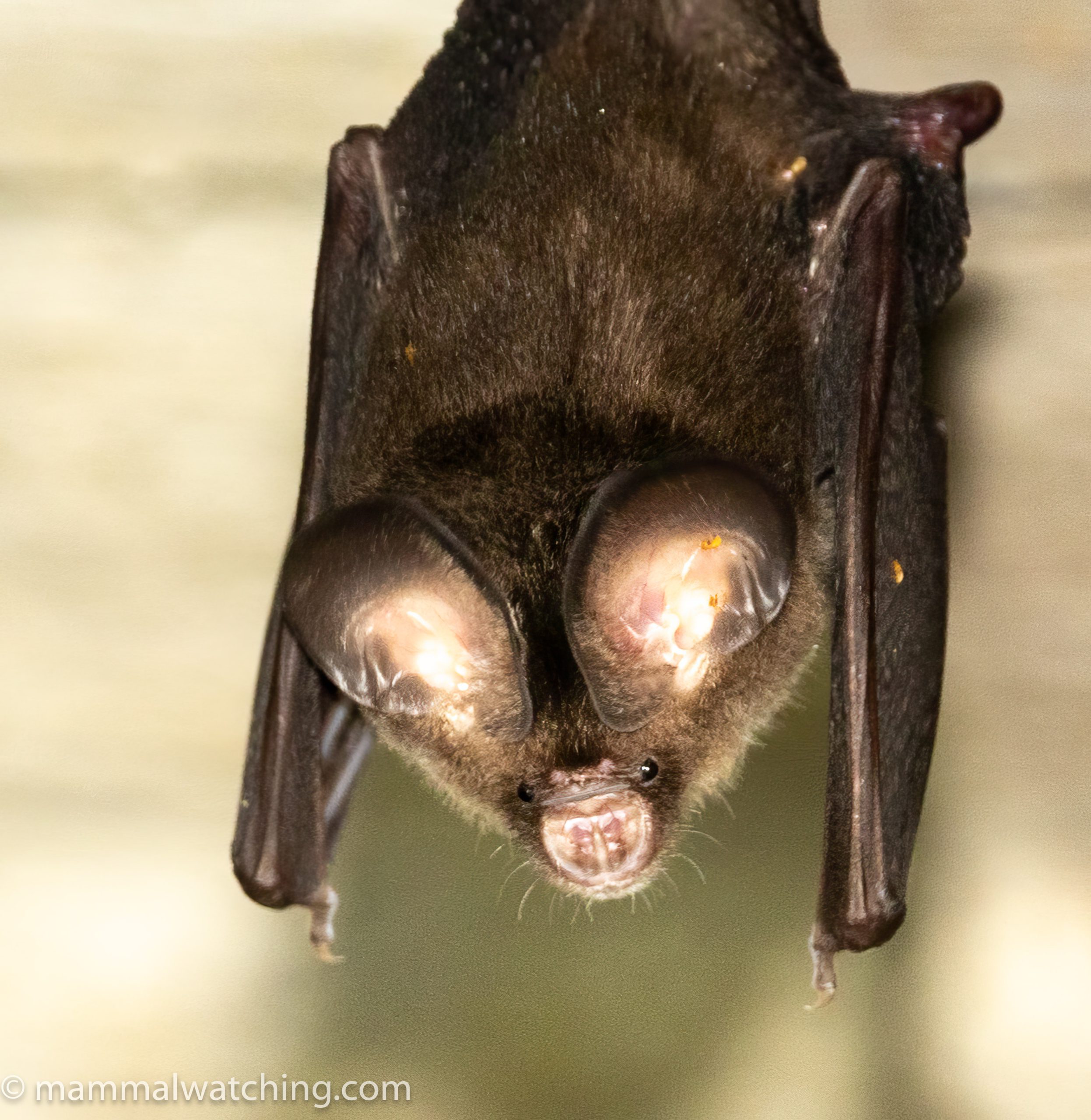
Batting in Kaeng Krachan and Khao Yai National Parks (Thailand), October 2023
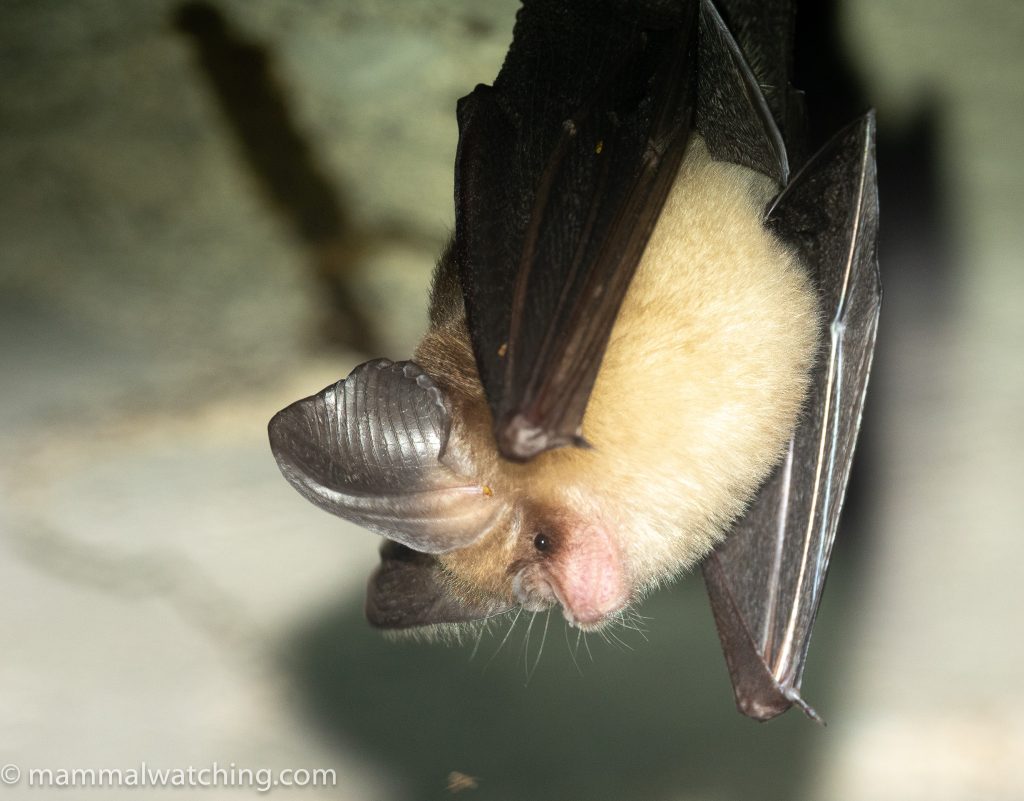
Andersen’s Leaf-nosed Bat (Hipposideros gentilis)
I was in Bangkok for a week’s work earlier this month and stayed on for a few days to visit a couple of national parks close to Bangkok with friends.
In downtown Bangkok there were plenty of Sunda Short-nosed Fruit Bats feeding on fruiting palms outside the Skyview Hotel in Sukhumvit. They were tricky to photograph properly though admittedly I didn’t put a lot of effort in.
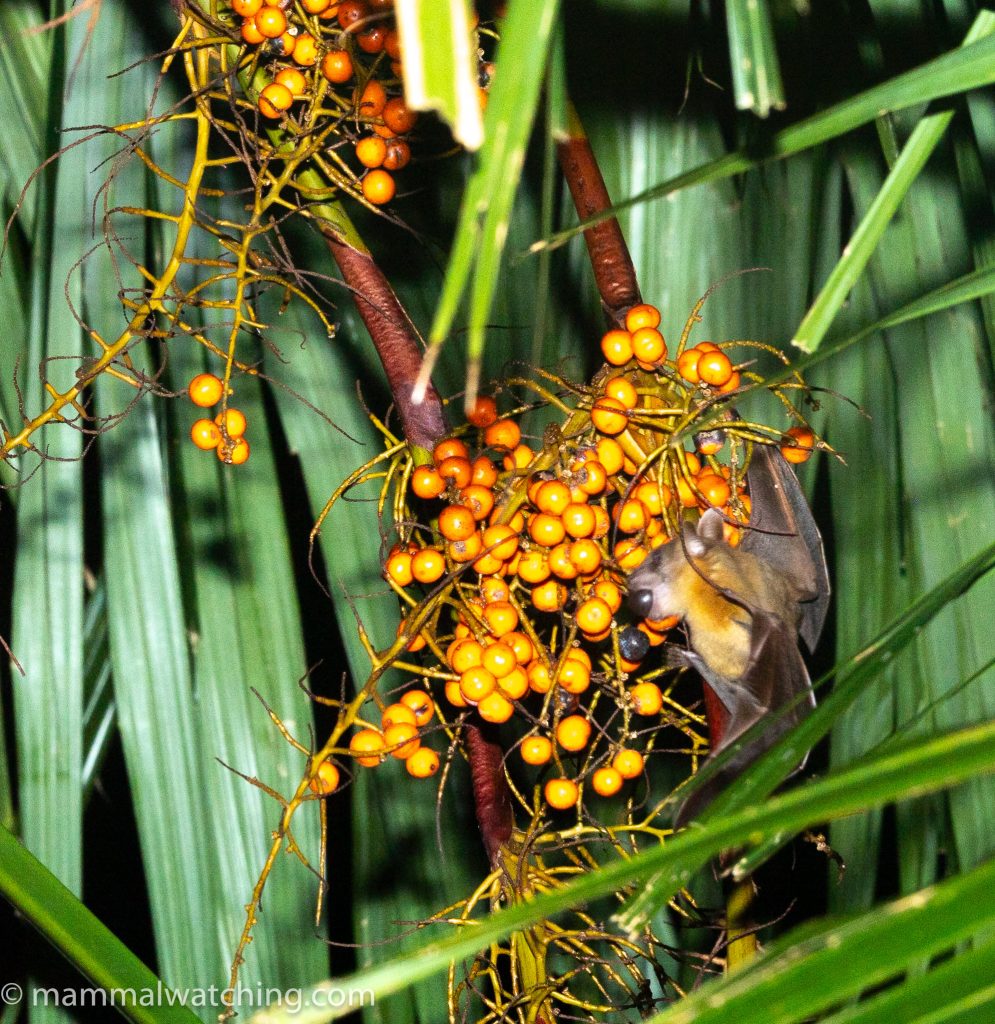
Sunda Short-nosed Fruit Bat (Cynopterus brachyotis)
Kaeng Karachan National Park
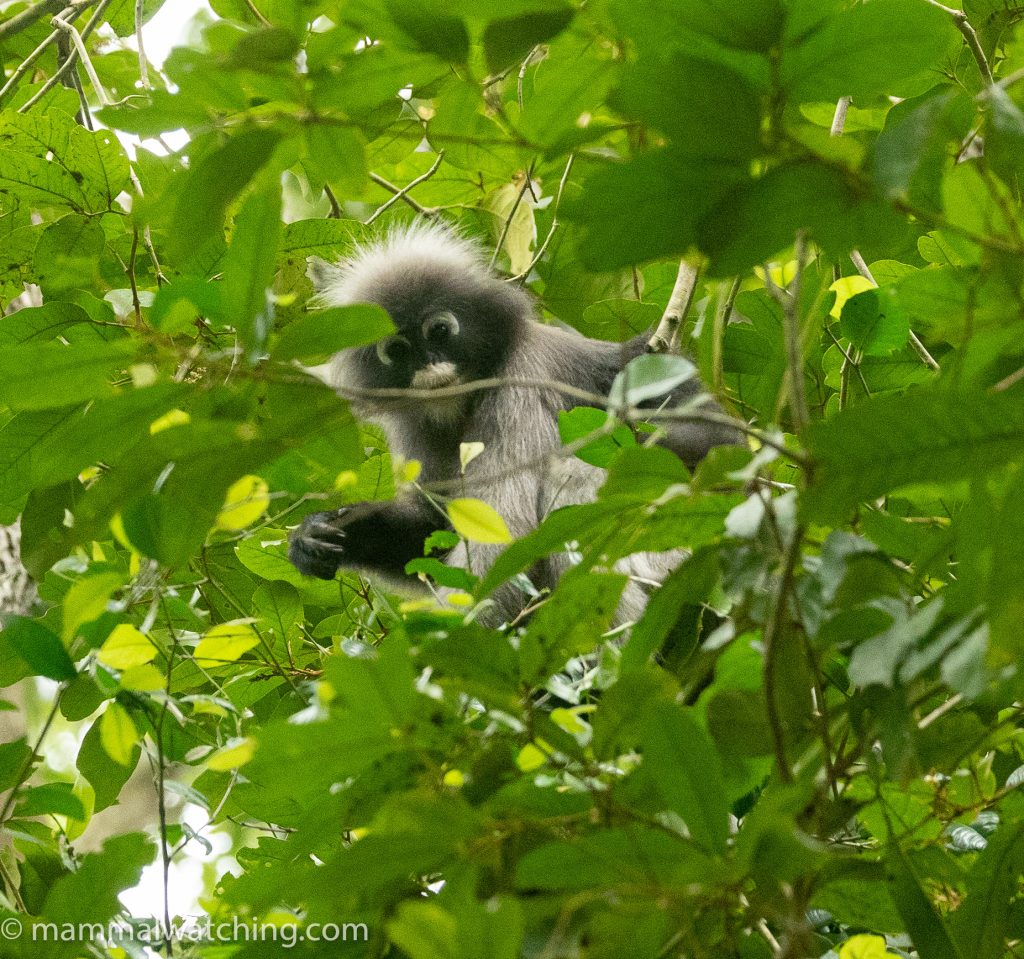
Dusky Leaf-monkey (Trachypithecus obscurus)
Coke Smith, who some of you might know from his ground breaking trip reports from 10 years or so ago – especially from his time in China – has been living in Bangkok for many years. He offered to visit Kaeng Krachan with me and collected me and my friends (Robyn and Nik – not yet mammalwatchers but may be on the path to conversion) from our hotels at 6.30am on Saturday to beat the infamous Bangkok traffic. We were checking into Baan Maka Nature Lodge just three and a half hours later. A lovely place to stay: exactly the right balance between comfort and simplicity, right on the edge of the national park with wildlife in the grounds. They even have London Pride (a British beer) in the fridge: something that seems impossible to find in New York. So when it rained all night I was not disappointed to realize there was nothing to do but drink it.
October is not a good time to visit Kaeng Krachan. Indeed every time I have been in Thailand it has not been a good time to visit: it has either been the rainy season or the park was shu because of damage in the rainy season.
In October, still in the thick of the wet season, the road up to the top of the mountain is closed and the wildlife is dispersed through the forest. Had it been the dry season I would have been looking for Fea’s Muntjacs in the higher elevations, or searching for black Leopards and Marbled Cats around the water holes. One day…
We spent most of Saturday hanging around the campsite inside the park hoping a Sun Bear might turn up. It didn’t, though the staff in the kitchen said two bears were visiting “every day” and I watched a video of a young bear rolling around on the grass with its head in a pot that was only missing the ‘Hunny’ label.
No Sun Bear appeared on Saturday or Sunday morning, and other friends – who were also there and stayed longer than me- reported that the bears did not appear on Monday or Tuesday either. So I would take the cook’s claims of daily visits with some skepticism. But I am sure they are still around.
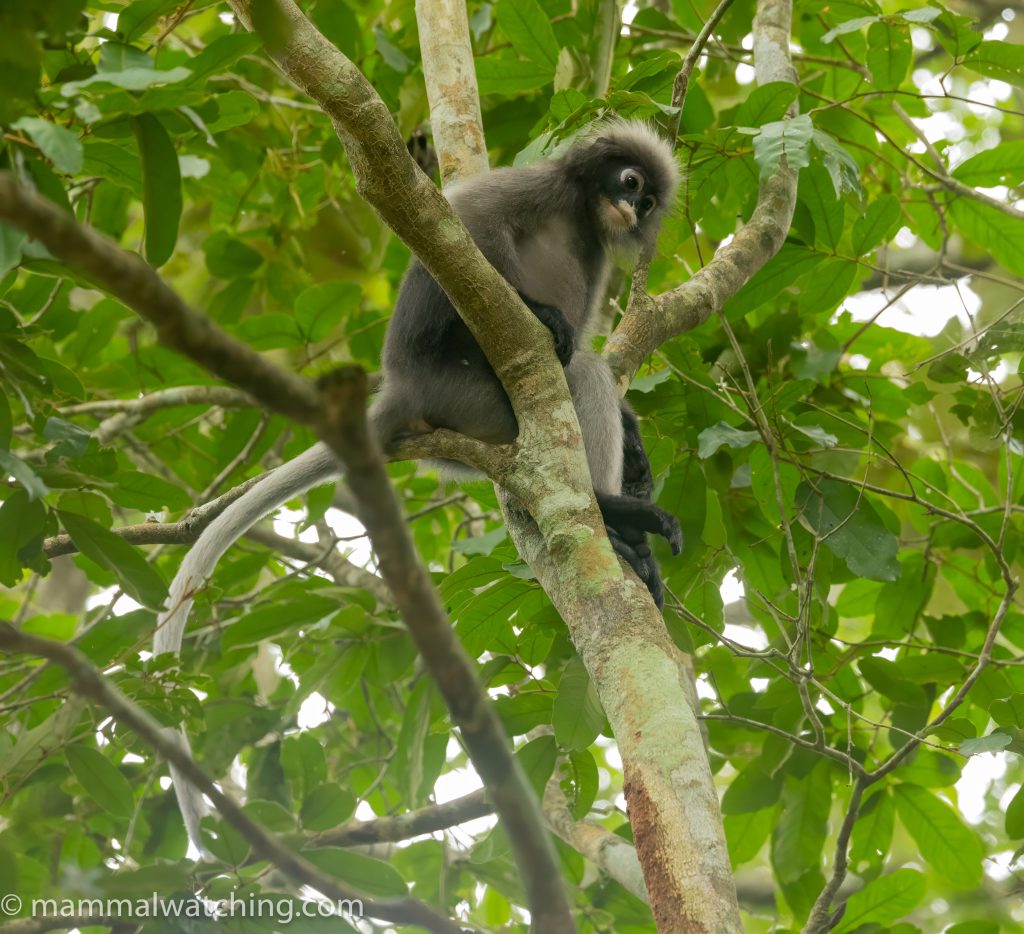
Dusky Leaf-monkey (Trachypithecus obscurus)
While we were waiting we enjoyed very confiding Dusky Langurs and Lar Gibbons in the campsite.
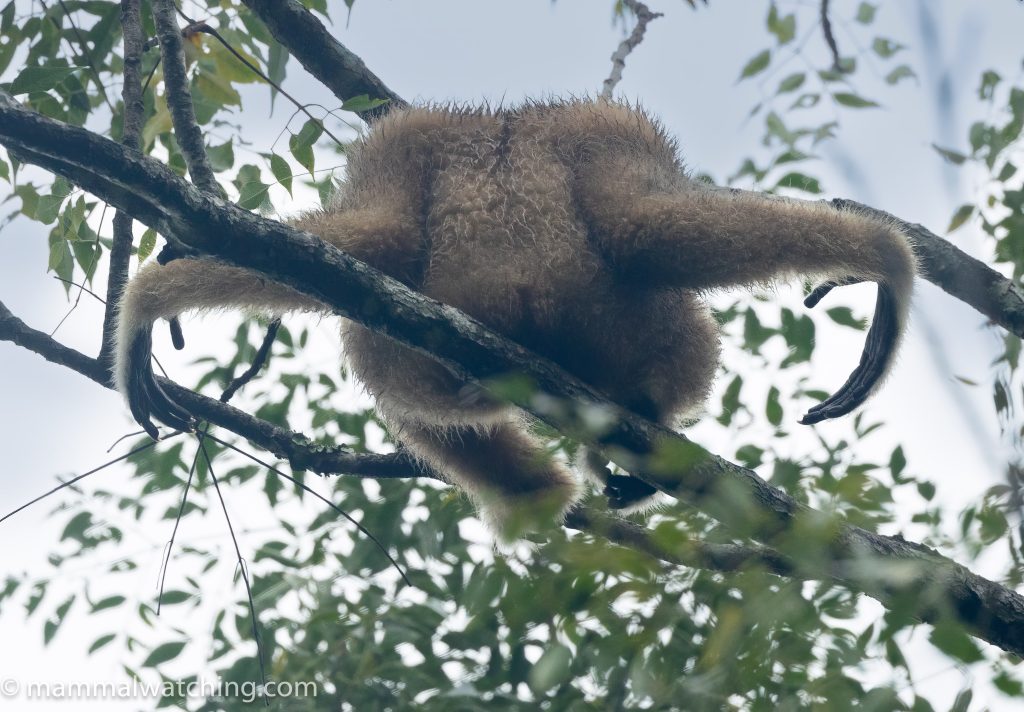
Lar Gibbon (Hylobates lar)
Life was so relaxed that I even found myself looking for birds with two friends from work, Adriana and Midori, who arrived a few hours after we did. Very alarming I know! A lesson in how easily this can happen if you let down your guard. Fortunately a Black Giant Squirrel appeared and I realized the imminent danger I was in.
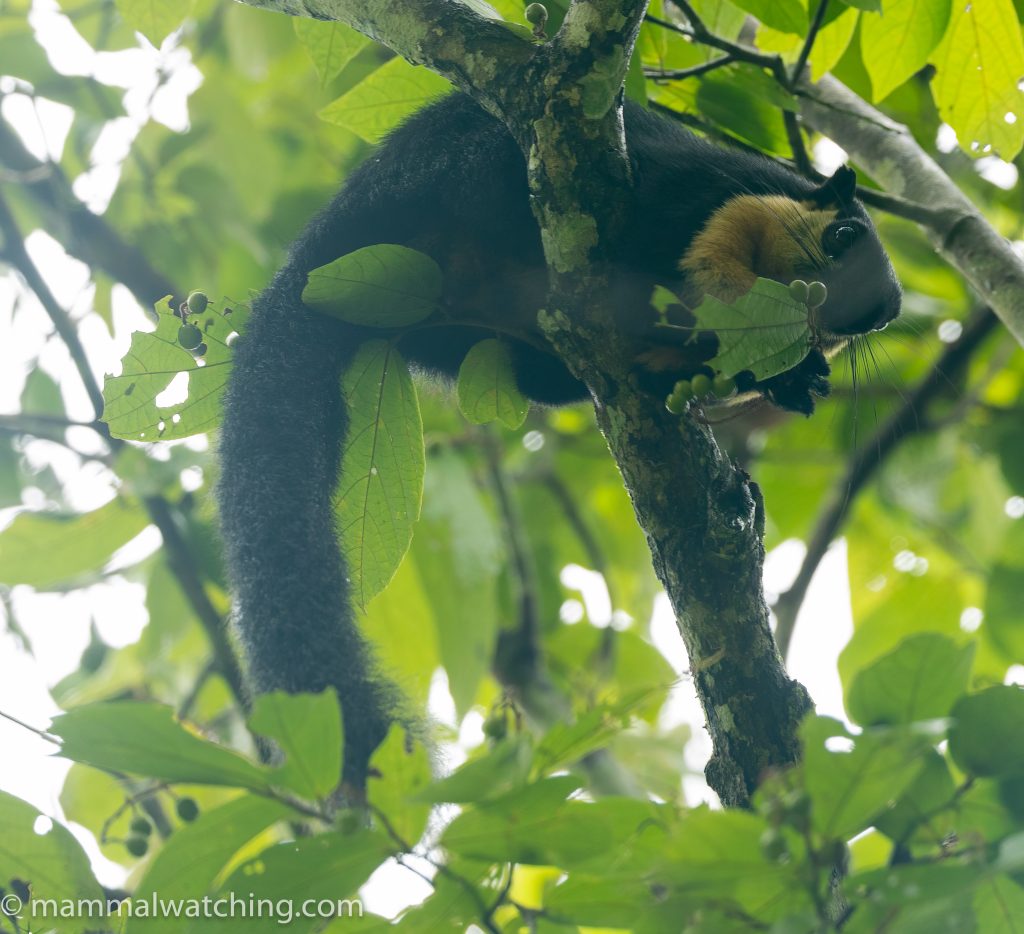
Black Giant Squirrel (Ratufa bicolor)
Still worried about the birding to mammalian ratio I messaged Carlos Bocos for help: he would be my choice of a sponsor if Birders Anonymous sever becomes a thing. Surely there was a lifer I could focus on… Carlos came through and told me he about the Woolly Bats in stands of bamboo he had found roosting along the first kilometer or so of the road up the hill from the campsite.
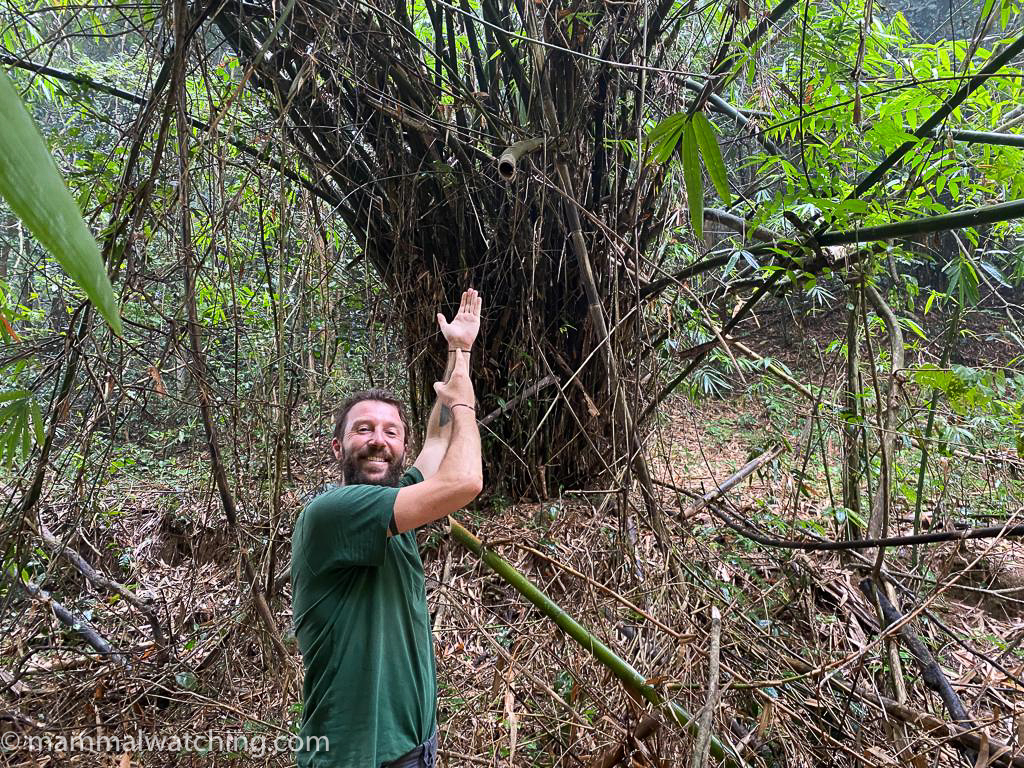
Carlos and a bat roost
When the rain stopped we drove and walked up the hill inspecting the many stands of bamboo. There were several slits in standing bamboo poles – perhaps chewed by bamboo bats – but we couldn’t find any animals. But after an hour of searching I found a small cluster of bats in a hollow pole projecting horizontally from a stand of bamboo (in pretty much the same way as the picture above).
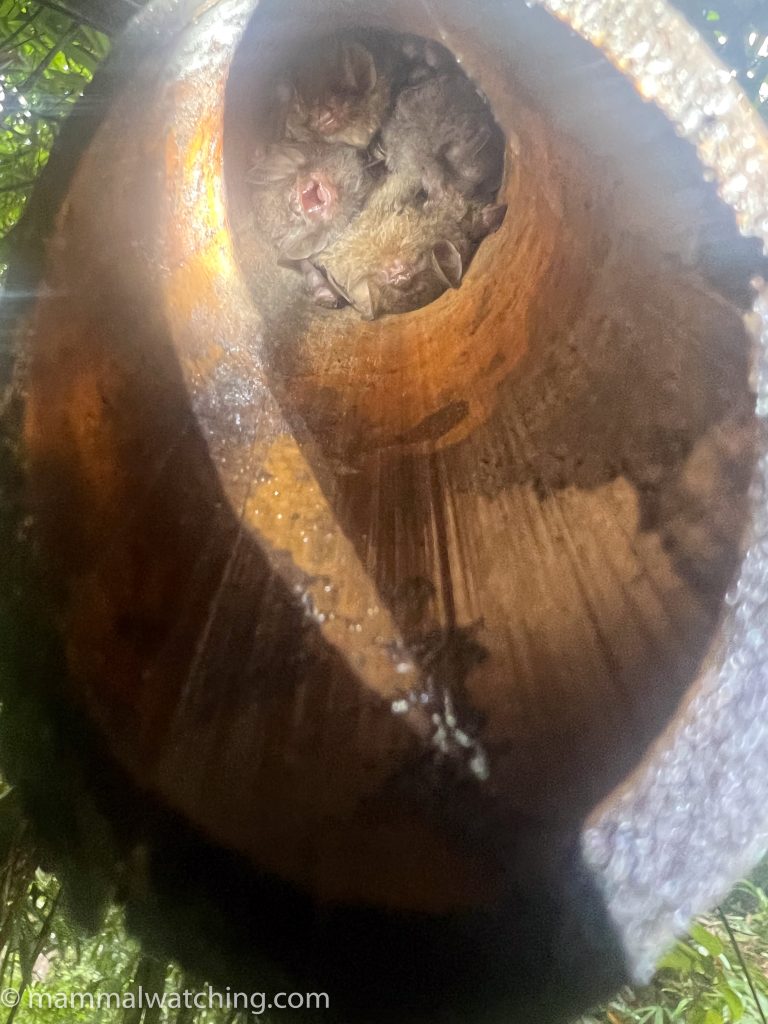
Common Woolly Bat (Kerivoula hardwickii)
They were hard to photograph with my phone but Coke managed to get much better pictures with his SLR. As Carlos had told me, and as Pipat Soisook, Thai bat expert, later confirmed, these are indeed Common (Hardwick’s) Woolly Bats. Carlos told me that the roost he had found was of considerable interest because the species had not been recorded roosting in bamboo before (only in pitcher plants and rolled up heliconia leaves).
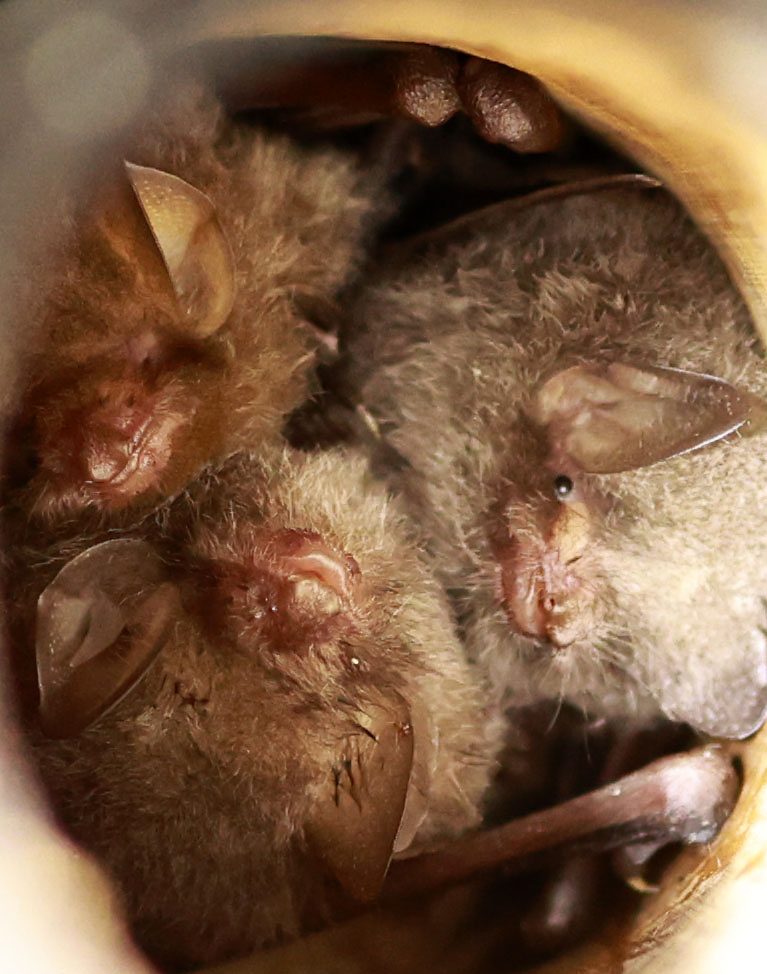
Common Woolly Bat (Kerivoula hardwickii). Photo Coke Smith.
There were a few Long-tailed Macaques along the road and Grey-bellied Squirrels running around the lodge gardens on Sunday morning. Slow Lorises are apparently easy to find around the lodge at night if you decide to forego the London Pride.
After lunch on Sunday, Coke drove me back to Bangkok where I met up with our friend Jirayu Ekkul (aka Tour) who was going to drive on to Khao Yai National Park with me for a few more bats. Jirayu runs Wild Encounter Thailand, and organizes mammal and bird trips across the country and beyond (he had just got back from West Papua). He also runs the excellent Eden’s Whale Watching trips out of Bangkok. A great guy that I had travelled with in 2017. I don’t know of anyone better to set up a mammalwatching trip around Thailand.
Khao Yai National Park
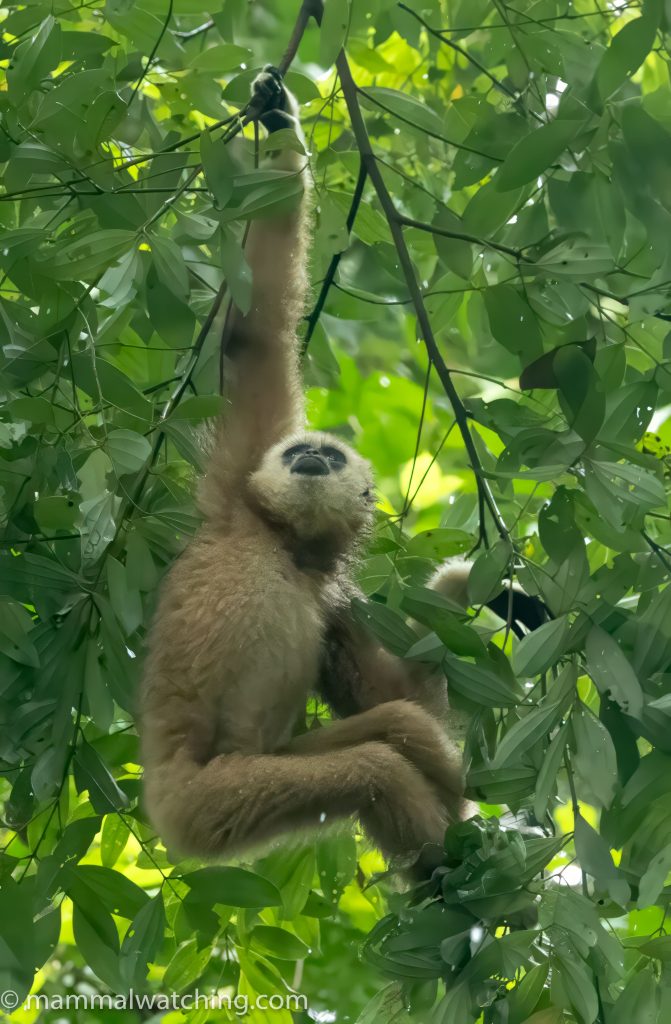
Lar Gibbon (Hylobates lar)
Tour and I got into the town of Mu Si, the gateway to Khao, just before midnight on Sunday. Even in the dark I was shocked about how much it had changed since my last visit. And when I did the math I was even more shocked to realise it was almost 20 years since I was last there.Back in 2006 I remember a nondescript town with one or two small hotels. Now it is more like the sort of sprawling collection of hotels, restaurants and tourist attractions that you find outside the most popular parks in the USA. There are hotels catering to every budget, a variety of restaurants and even a Hokkaido Flower Garden, whatever that is. We had some good Italian food, excellent Thai food from the market, and two cups of really fantastic coffee from the Mellow Mill coffee shop that would be notably good in Australia.
We spent 36 hours here mainly searching for bats:outside the park on Monday and the inside the park on Tuesday morning.
Our first goal though was to see a Serow. This was a bogey animal for me in Thailand. I missed them several times in the early 2000s, sometimes by a matter of minutes. Although I later saw what is now the same species in China I was very keen to see one in Thailand to lay the ghosts of past failures to rest. Also their taxonomy seems quite fluid and the species in Thailand may be split, again, from the Serow in China.
Coke and Tour knew the spot to look. We needed to visit this carpark in front of a temple at dawn and scan the top off the small hill directly across the road in front of us. The Serows usually appear on the rocks at the very top of the hill as the sun rises.
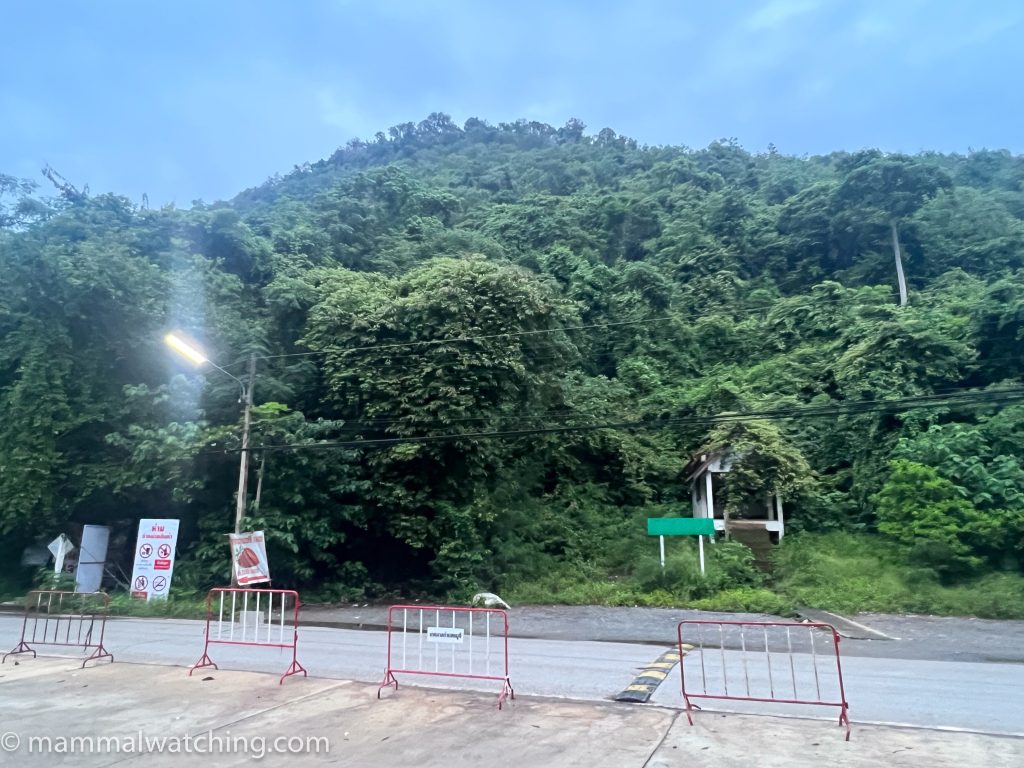
Spot the Serow
It was overcast, with terrible light for photography, but pretty much on the dot of the official sunrise time a Serow appeared on the top of the hill and surveyed his – or her – kingdom for half an hour. Magic. If only it was always this easy. Tour explained that in the dry season the hill looks completely different with far more of the limestone exposed.
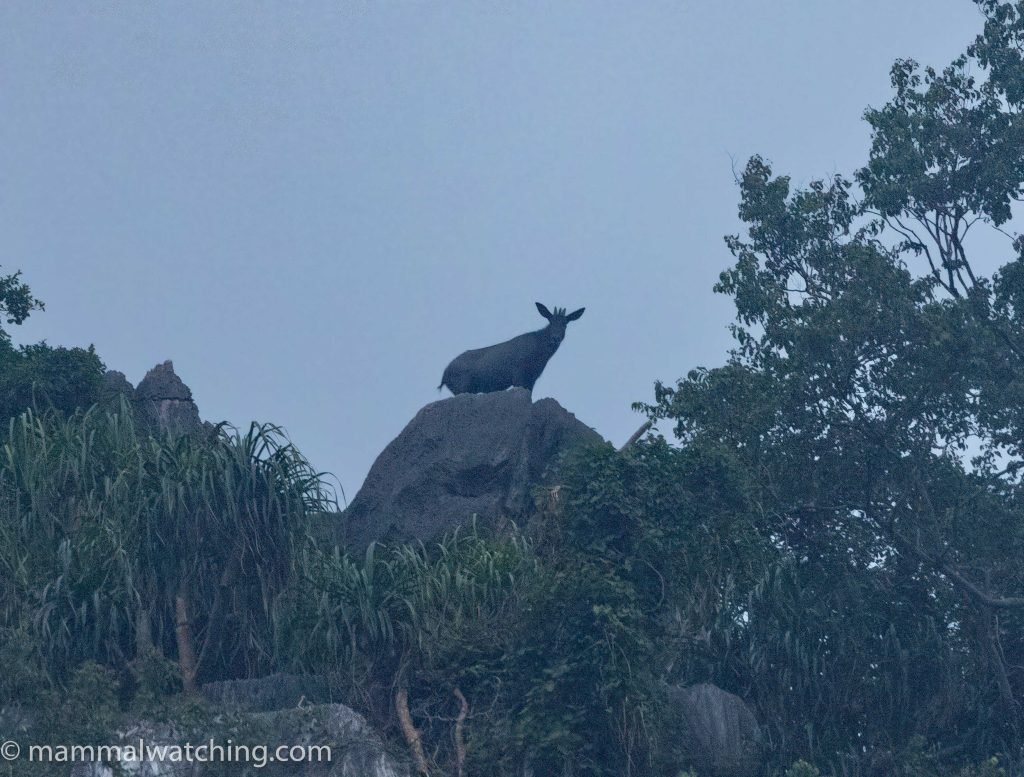
Serow (Capricornis sumatraensis)
While we were waiting for the light to improve a white morph Finlayson’s (Variable) Squirrel put on a show in a tree on the roadside.
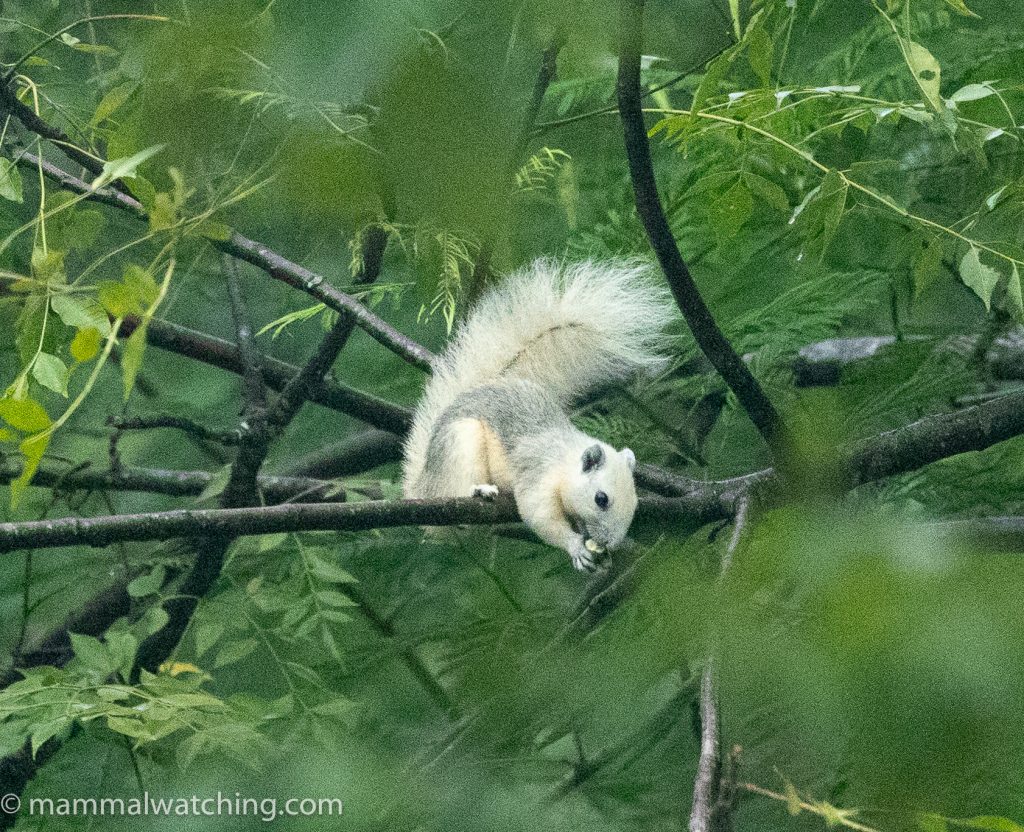
Finlayson’s Squirrel (Callosciurus finlaysonii)
Twenty minutes later the light had not improved and this was our last view of the Serow before it lay down on top of the rock.
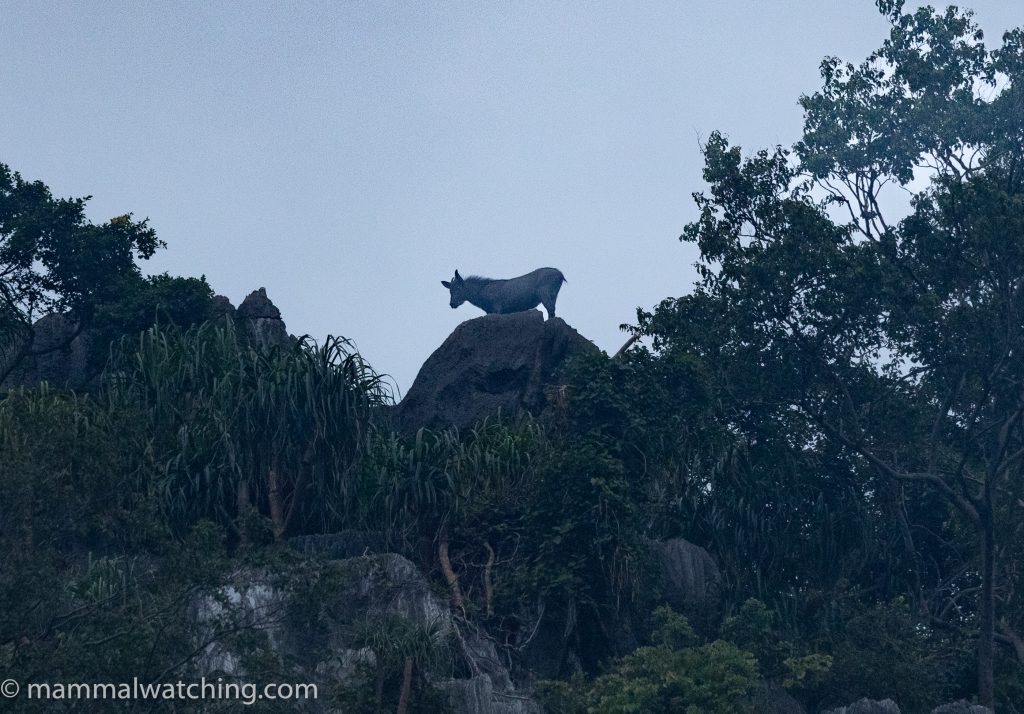
Serow (Capricornis sumatraensis)
We spent the rest of the day visiting three sets of caves, each attached to their own Buddhist temple. Access to all the caves was straightforward although Tour had to ask for directions from the monks in the first temple to find the right path. Access is free though it is customary to tip the monks a few hundred baht. When I got home Pipat Soisook very quickly helped me to identify all the species we had seen.
Wat Thewarup Songtham Temple
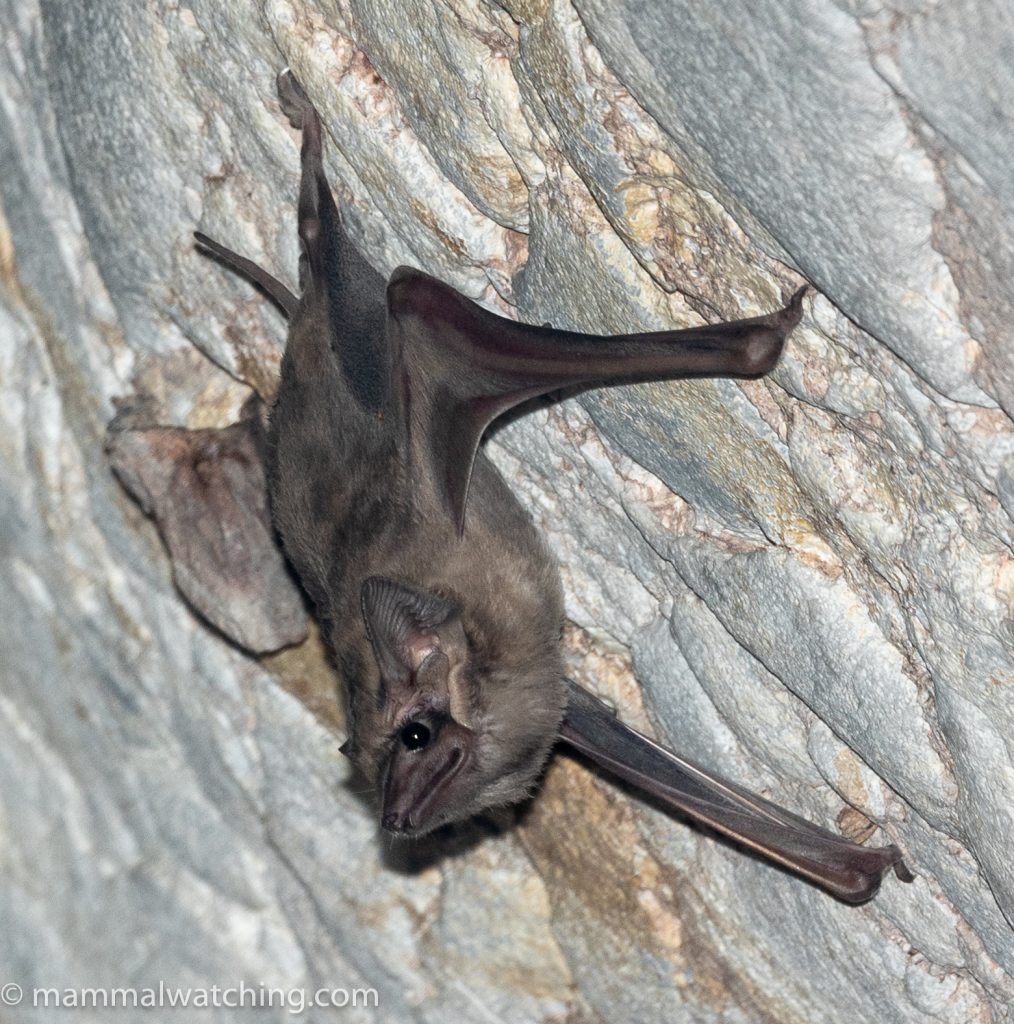
Black-bearded Tomb Bat (Taphozous melanopogon)
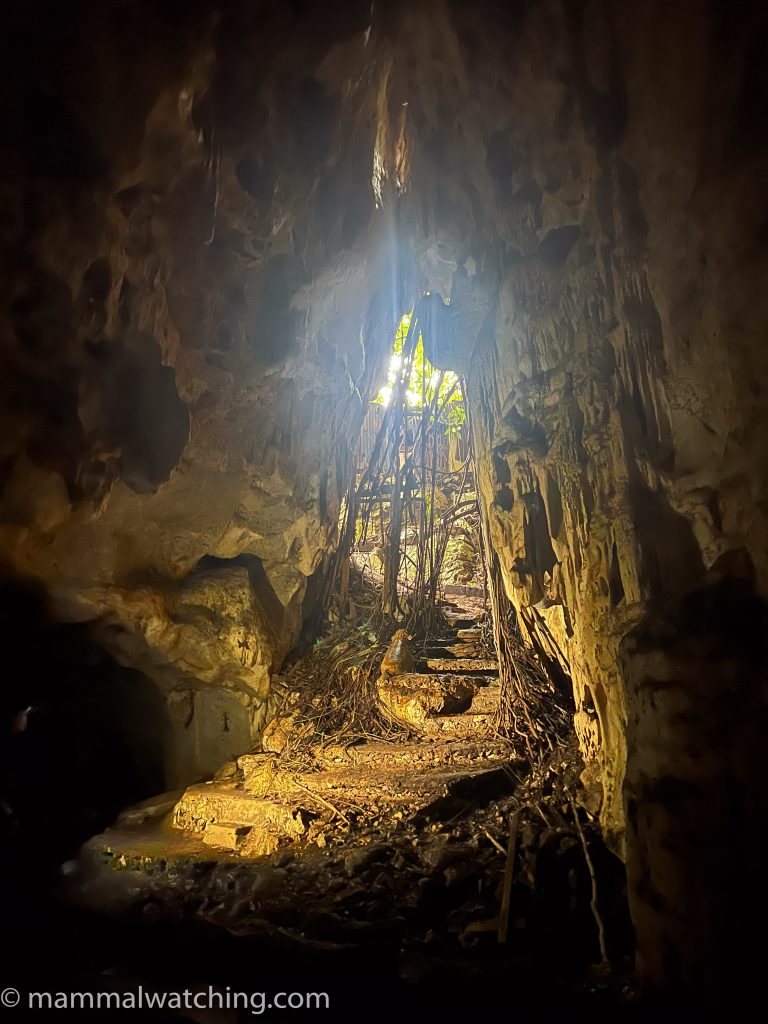
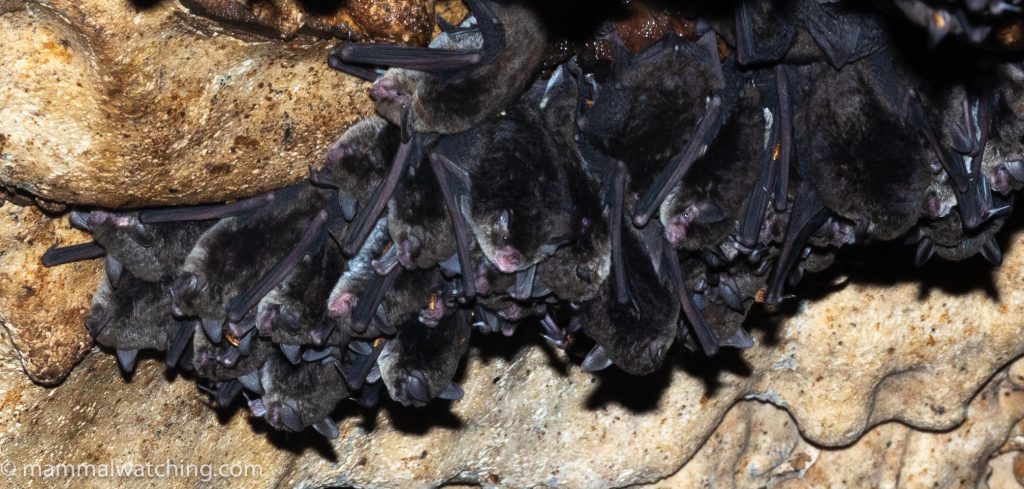
Himalayan Whiskered Bat (Myotis siligorensis)
Wat Sa Nam Sai Temple.
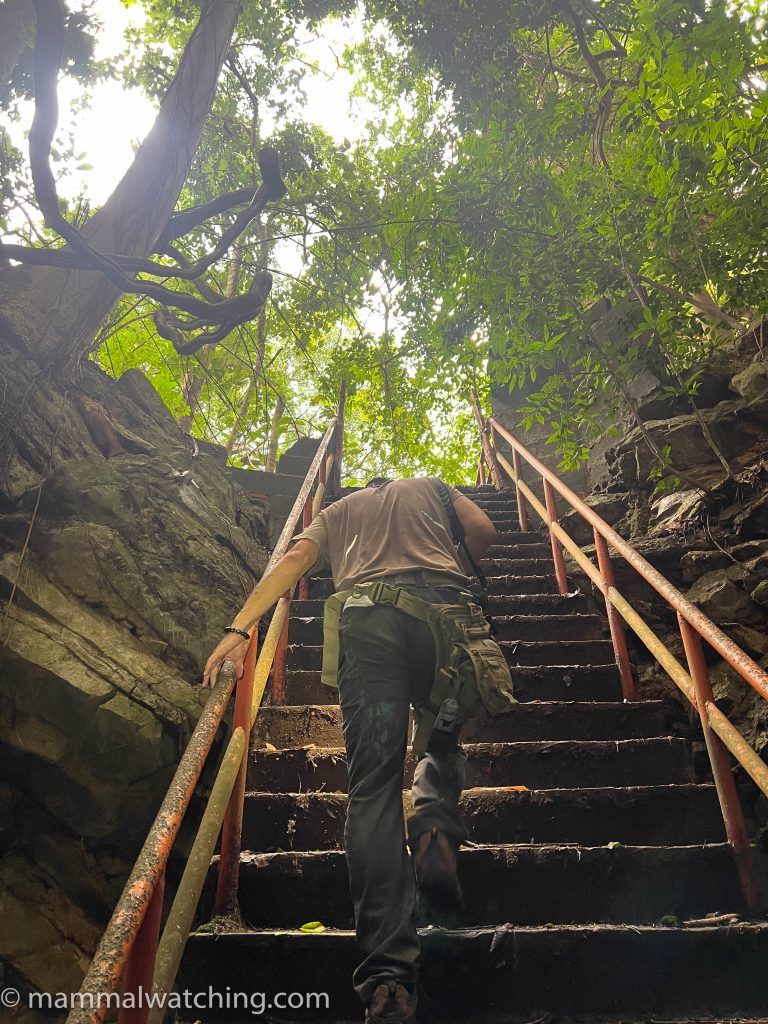
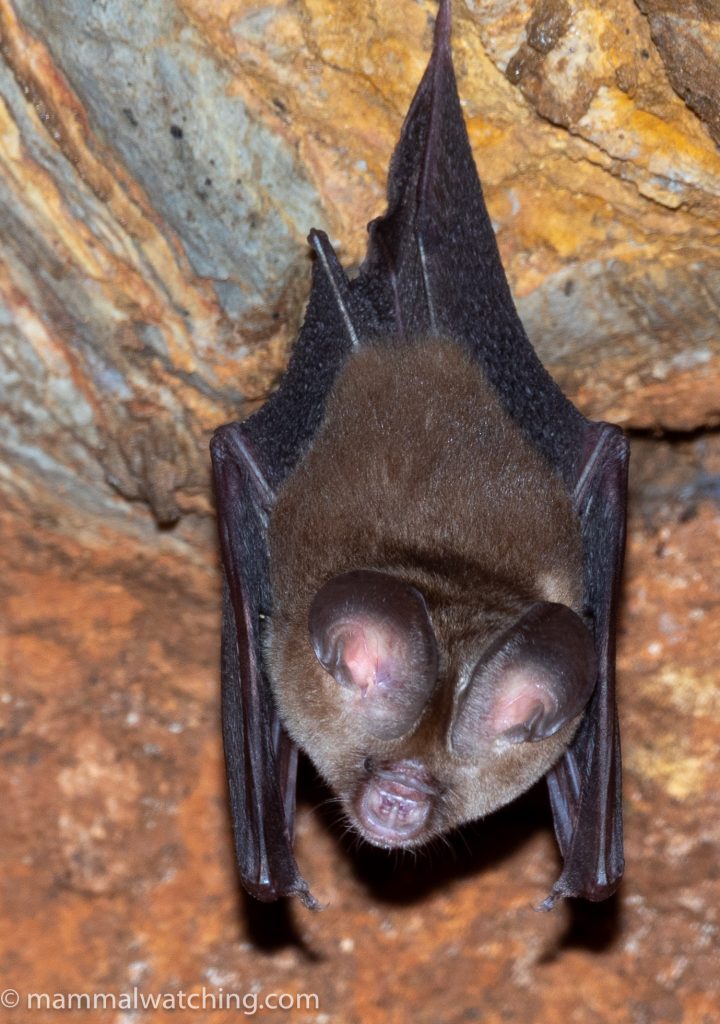
Andersen’s Leaf-nosed Bat (Hipposideros gentilis)
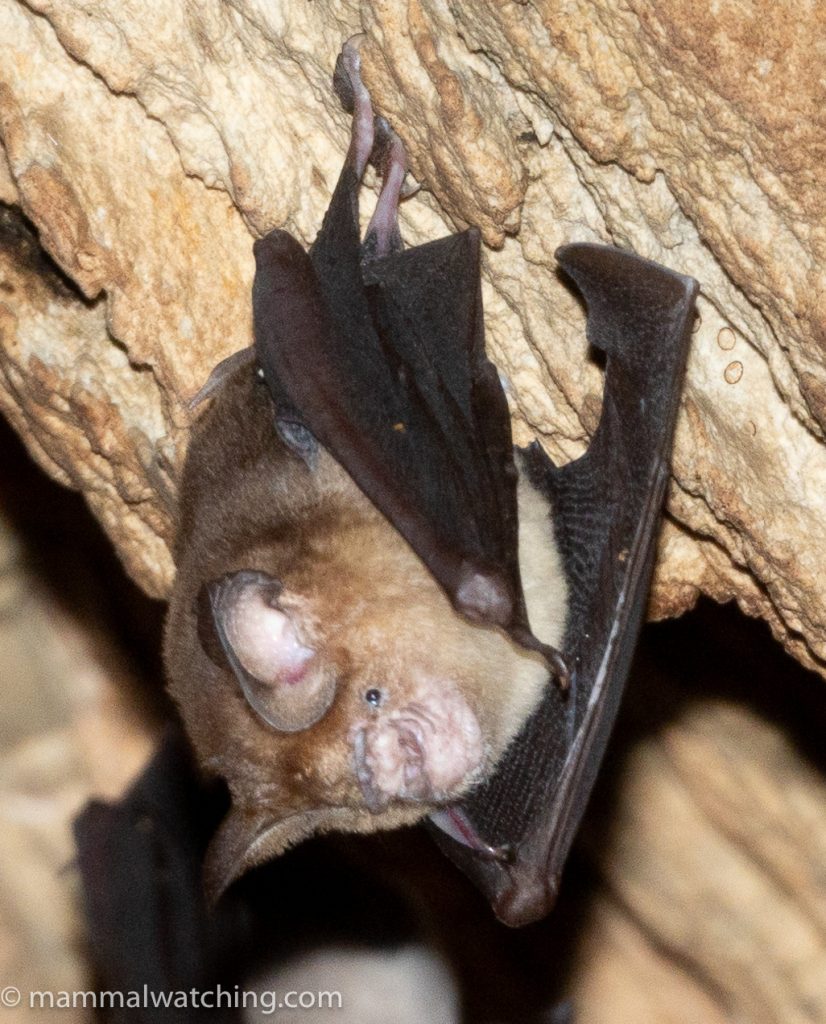
Horsfield’s Leaf-nosed Bat (Hipposideros larvatus)
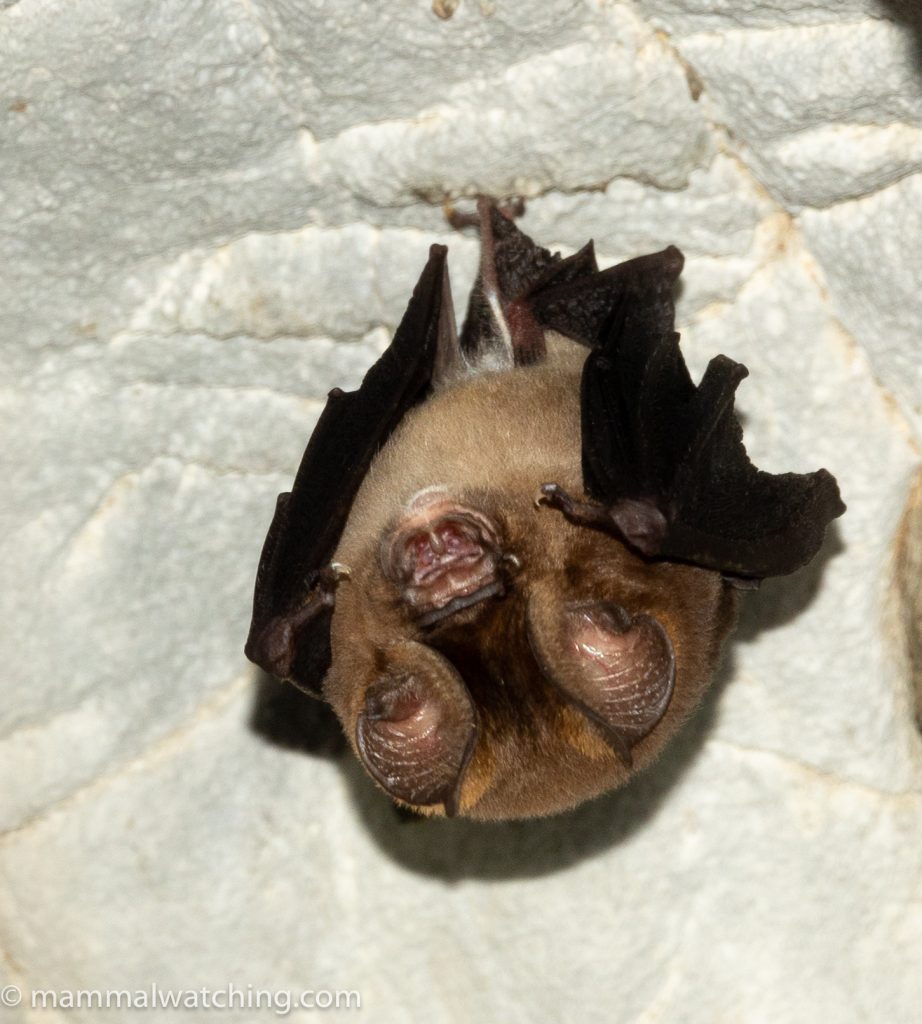
Cantor’s Leaf-nosed Bat (Hipposideros galeritus)
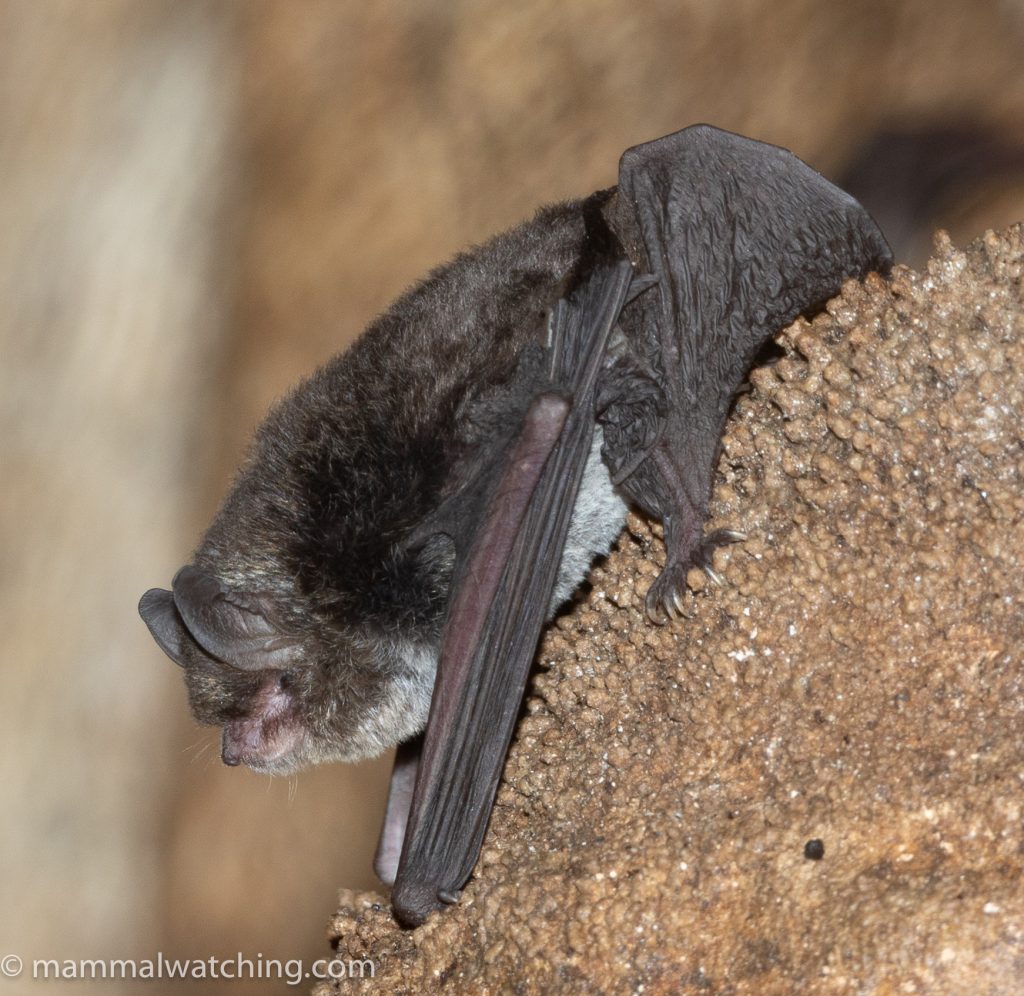
Himalayan Whiskered Bat (Myotis siligorensis)
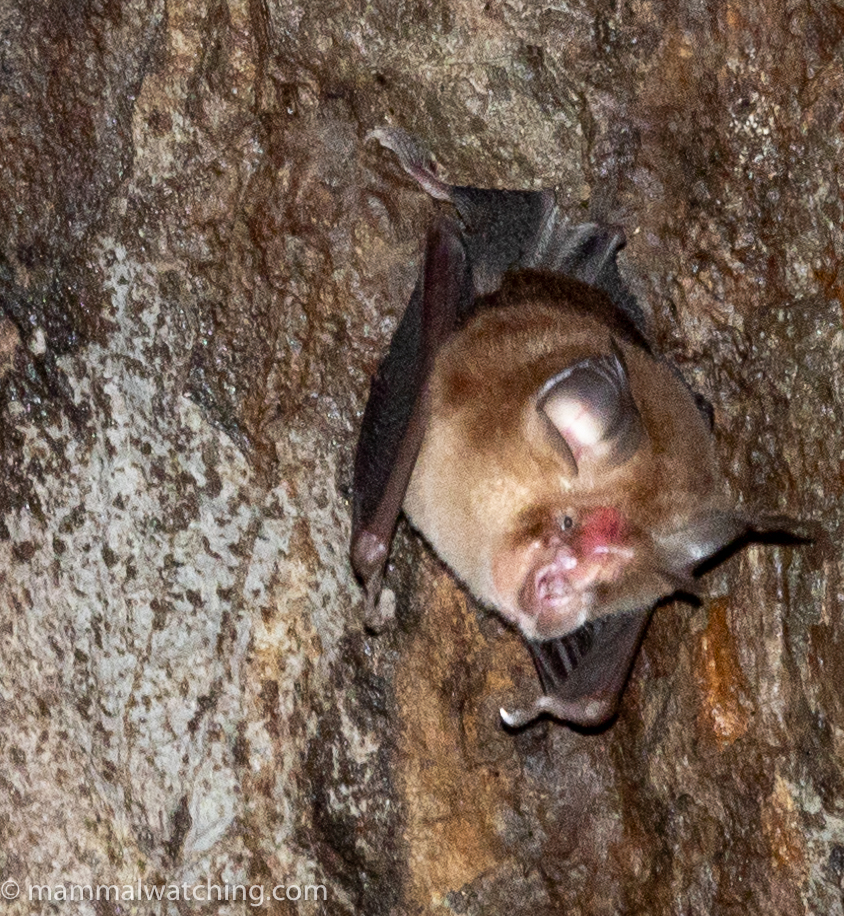
Shamel’s Horseshoe Bat (Rhinolophus shameli)
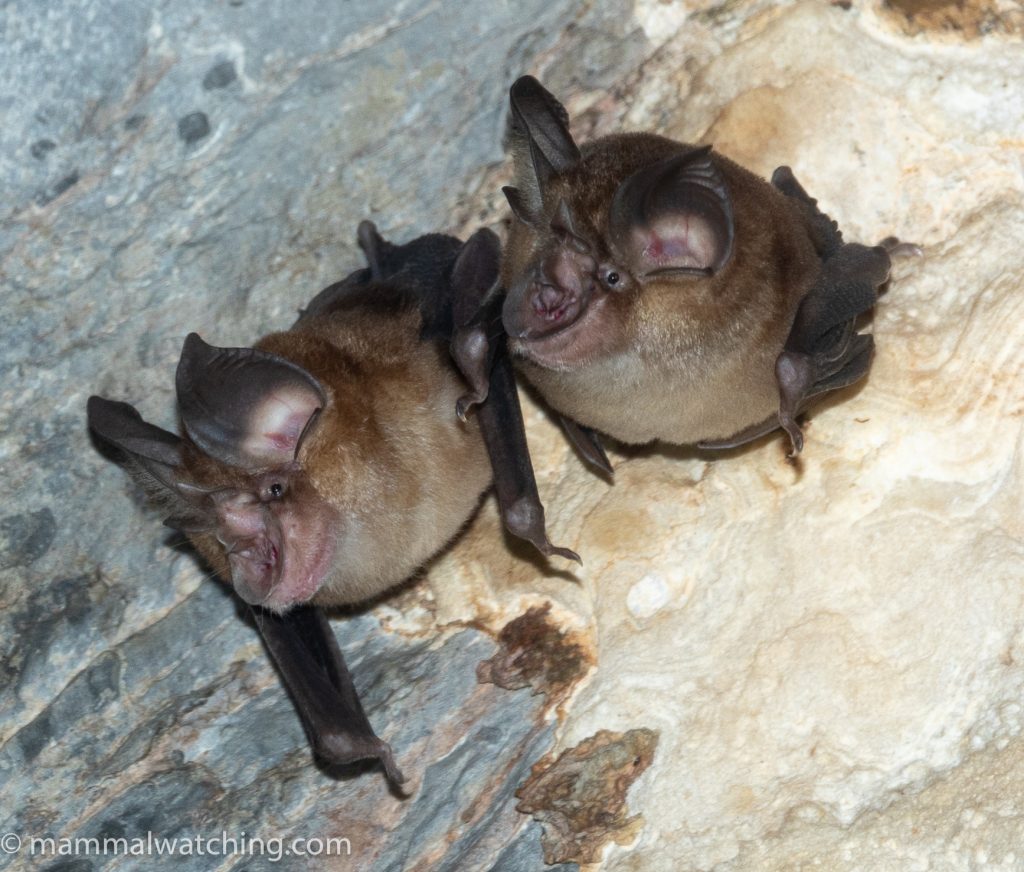
Malayan Horseshoe Bat s(Rhinolophus malayanus)
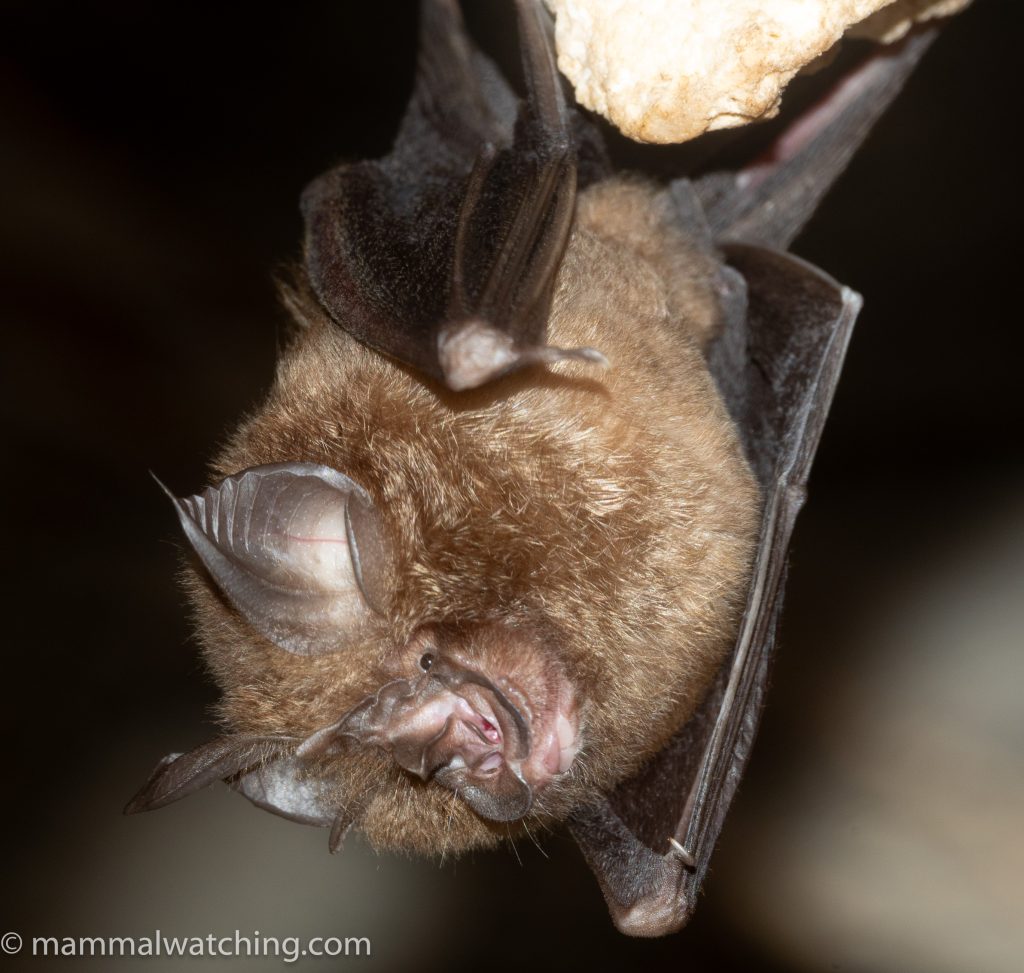
Pearson’s Horseshoe Bat (Rhinolophus pearsonii)
Wat Tham Sila Thong Temple
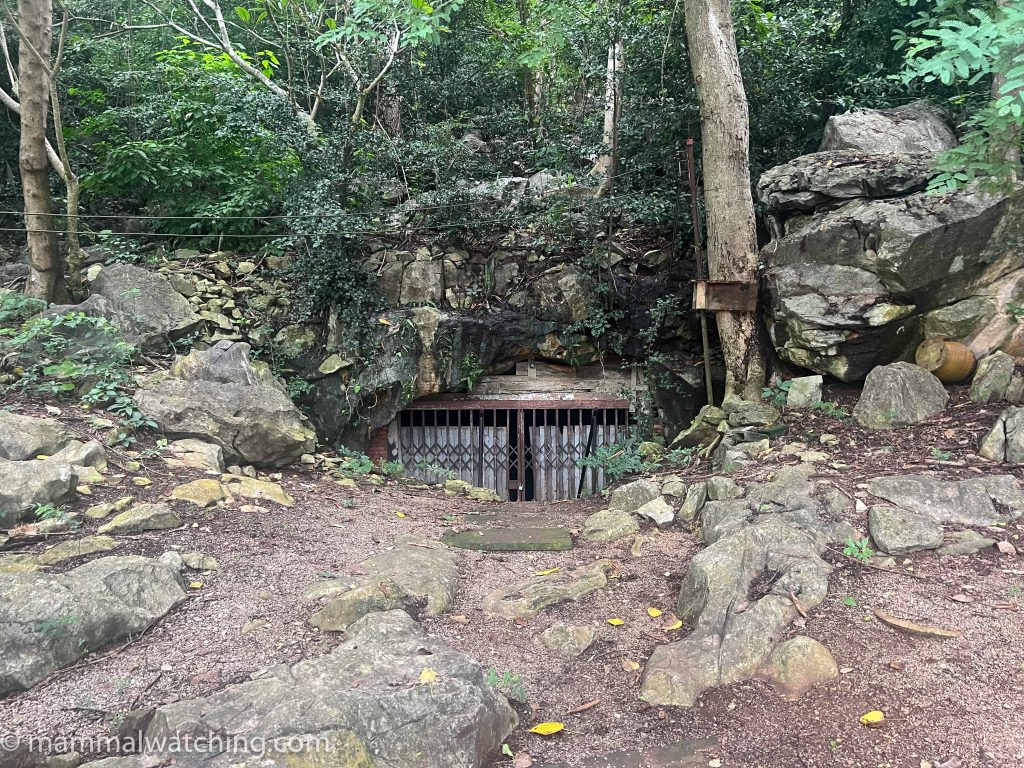
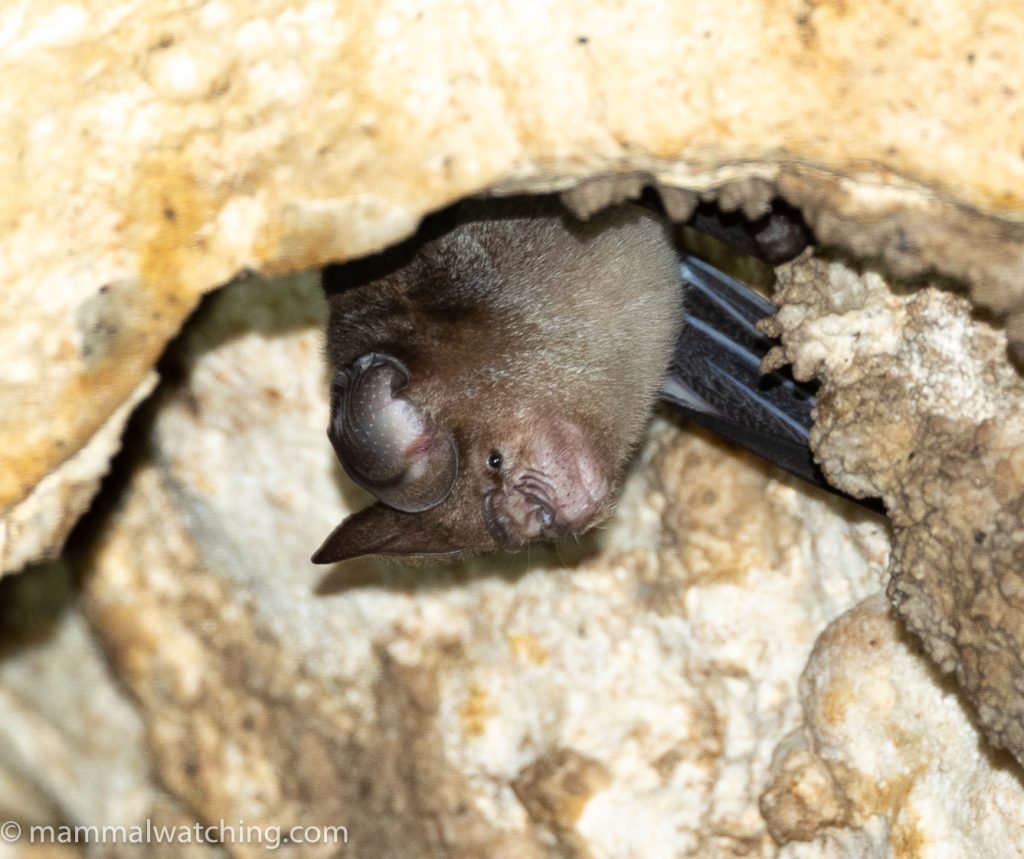
Horsfield’s Leaf-nosed Bat (Hipposideros.larvatus)
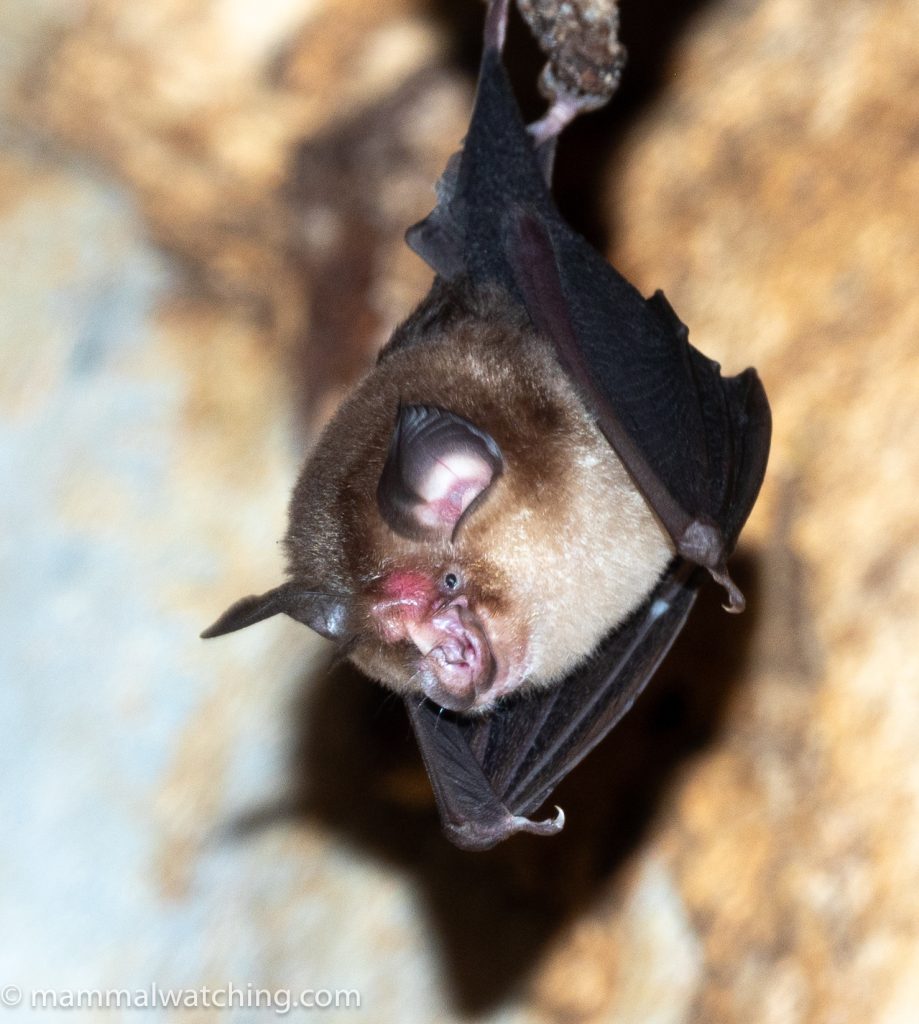
Shamel’s Horseshoe Bat (Rhinolophus shameli)
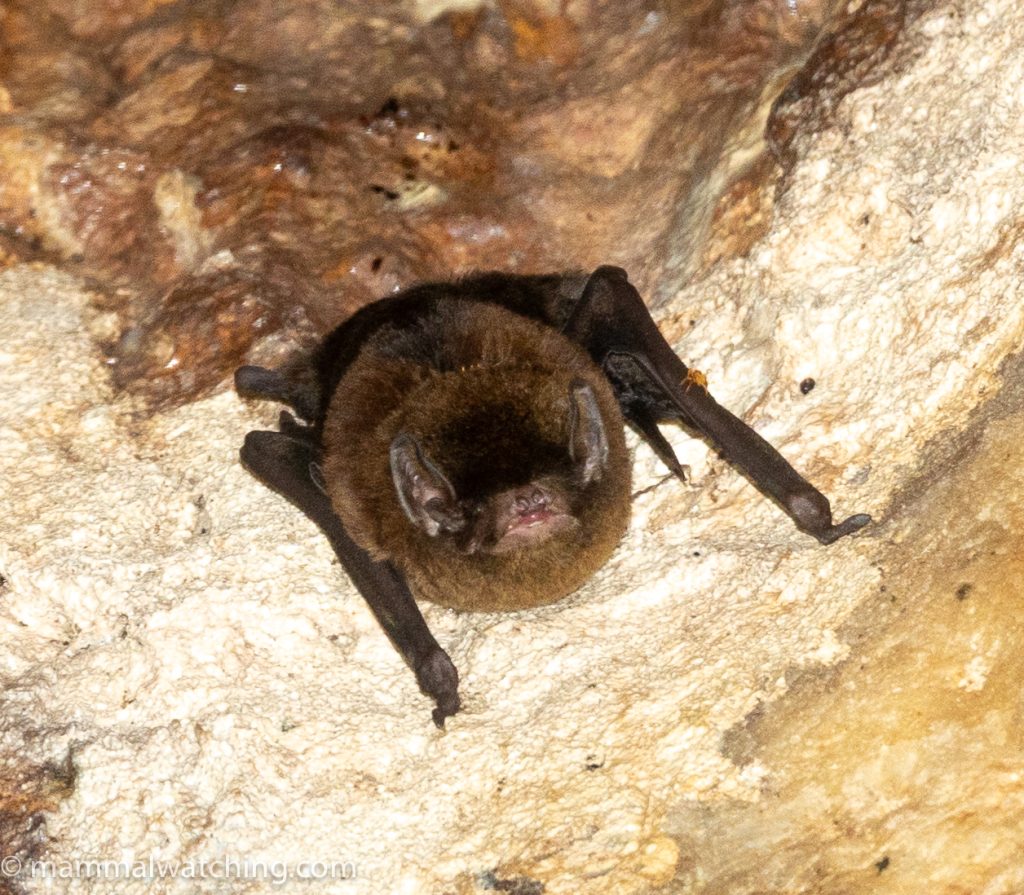
Medium Bent-winged Bat (Miniopterus medius)
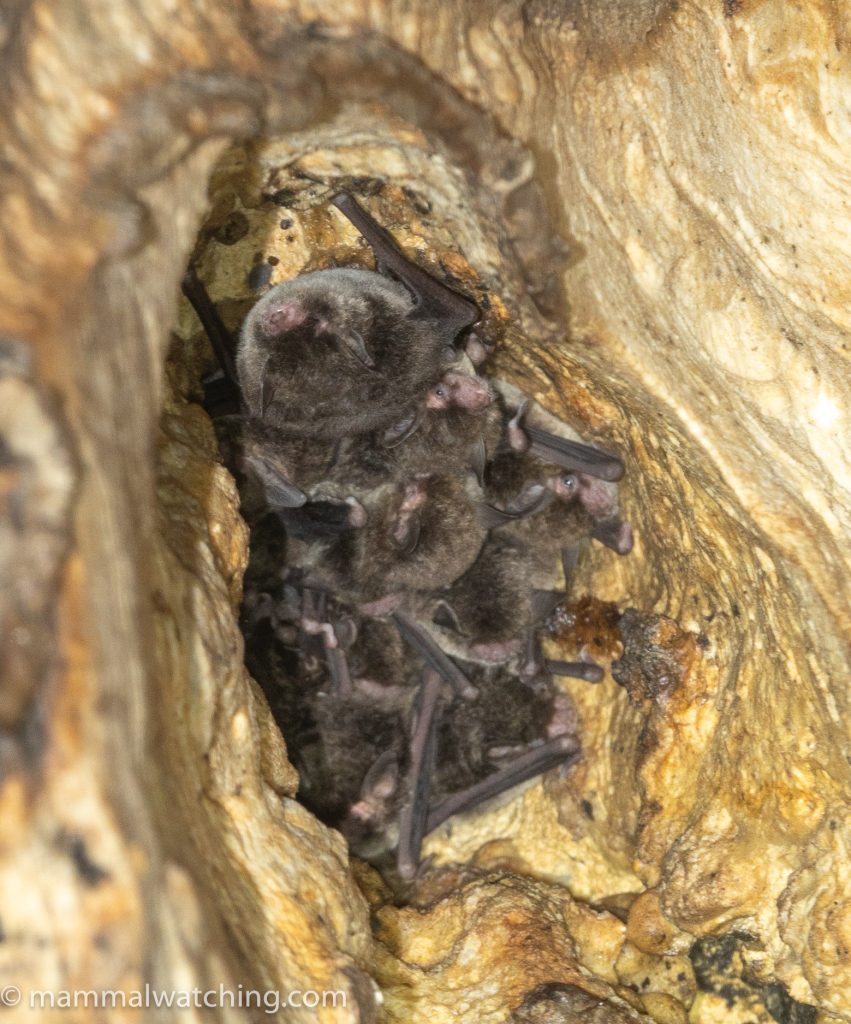
Possible Lesser Large-footed Myotis (Myotis hasseltii)
Khao Yai National Park
On Tuesday Tour and I drove into the national park.
We saw a few Pig-tailed Macaques along the road and a Northern Red Muntjac crossed in front of us.
Our first stop was the trail at kilometer 33 on the park entrance road. A group of Lar Gibbons were hanging out in the canopy and we easily found the large hollow tree that Coke Smith told me about: it was about 50 meters along a side trail that branched to the left off of the main trail at the very start.
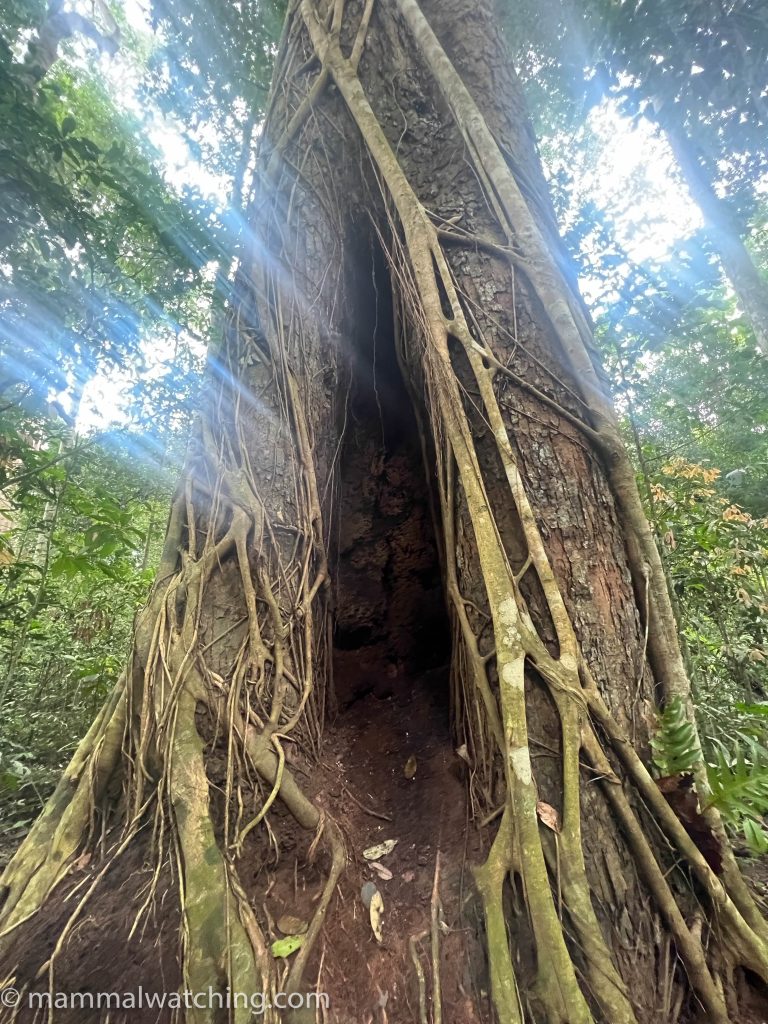
A few Lesser False Vampires were roosting inside.
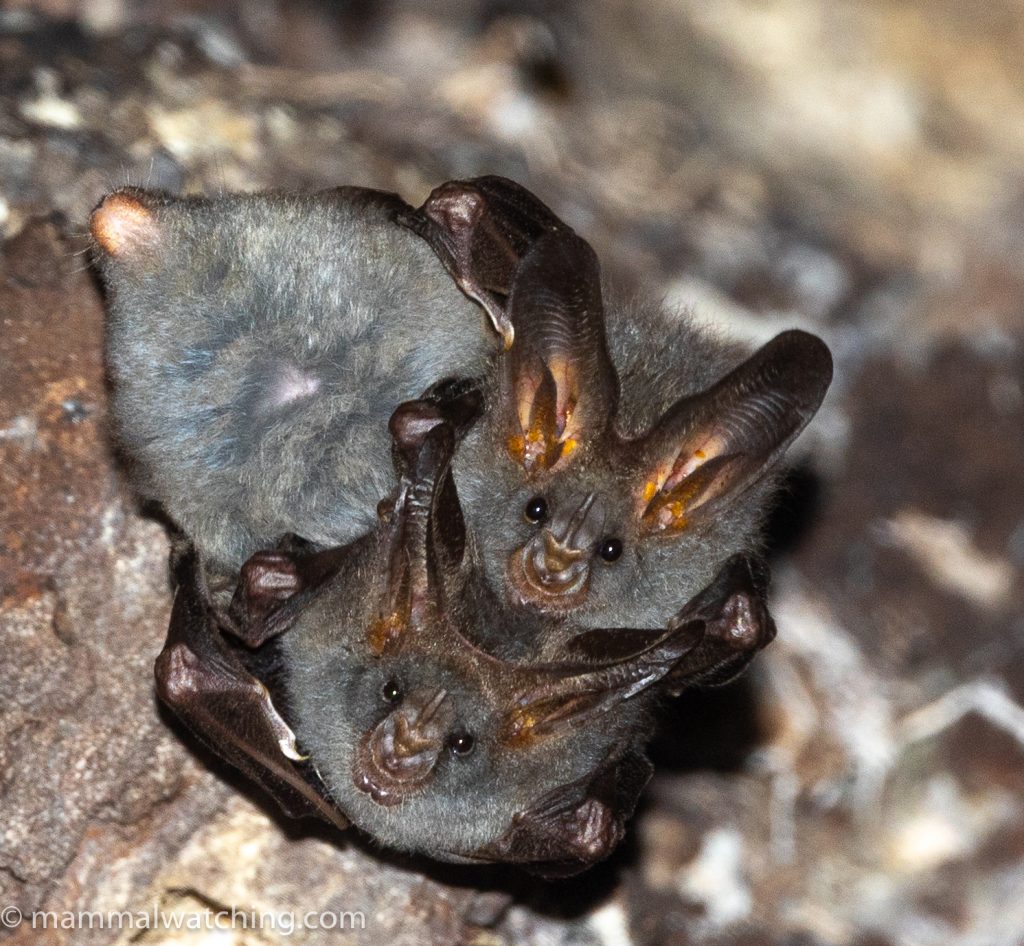
Lesser False Vampires (Megaderma spasma)
Despite checking several hollow trees – and logs – along the trail we could not find any of the Northern Woolly Horseshoe Bats that Carlos had found inside a fallen tree a year earlier. Beware the trail here is not a loop as we had thought. We ended up at the watchtower, 2 kilometers down the road from where we had left the car. Thankfully it was a cool day.
Our final stop was the Khao Yai visitor centre. Carlos told me to check out the basement area (on the left hand side of the building).
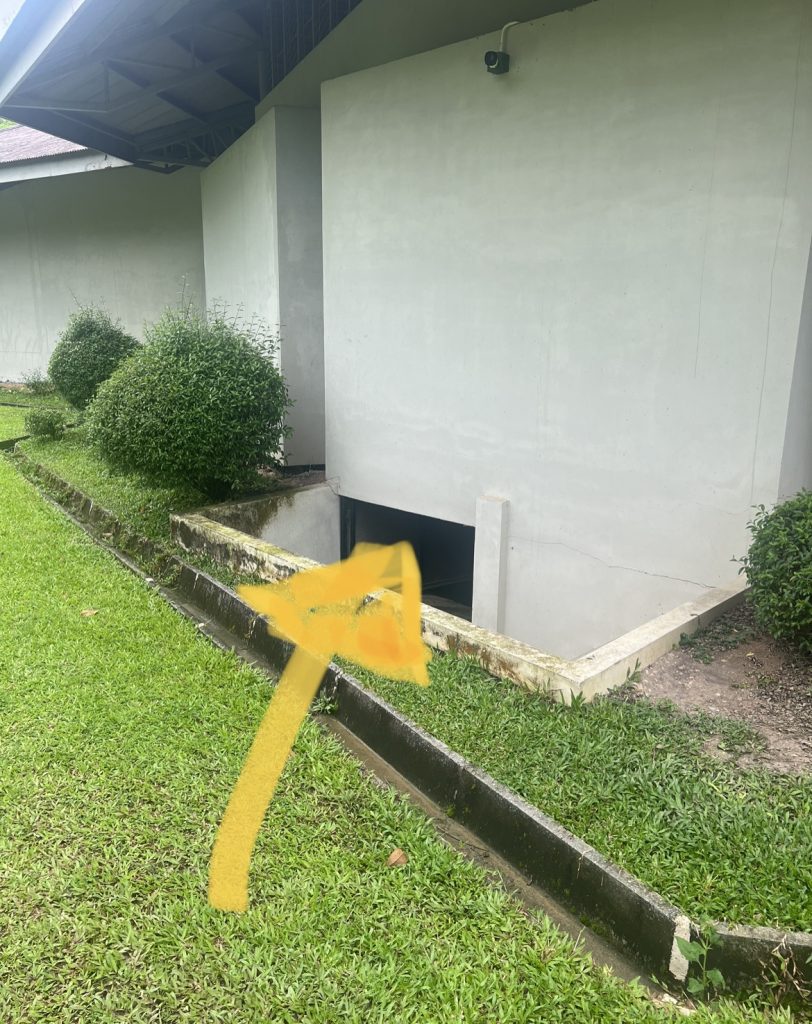
Sure enough there were plenty of bats hanging from the ceiling. Mainly Andersen’s Leaf-nosed Bats.
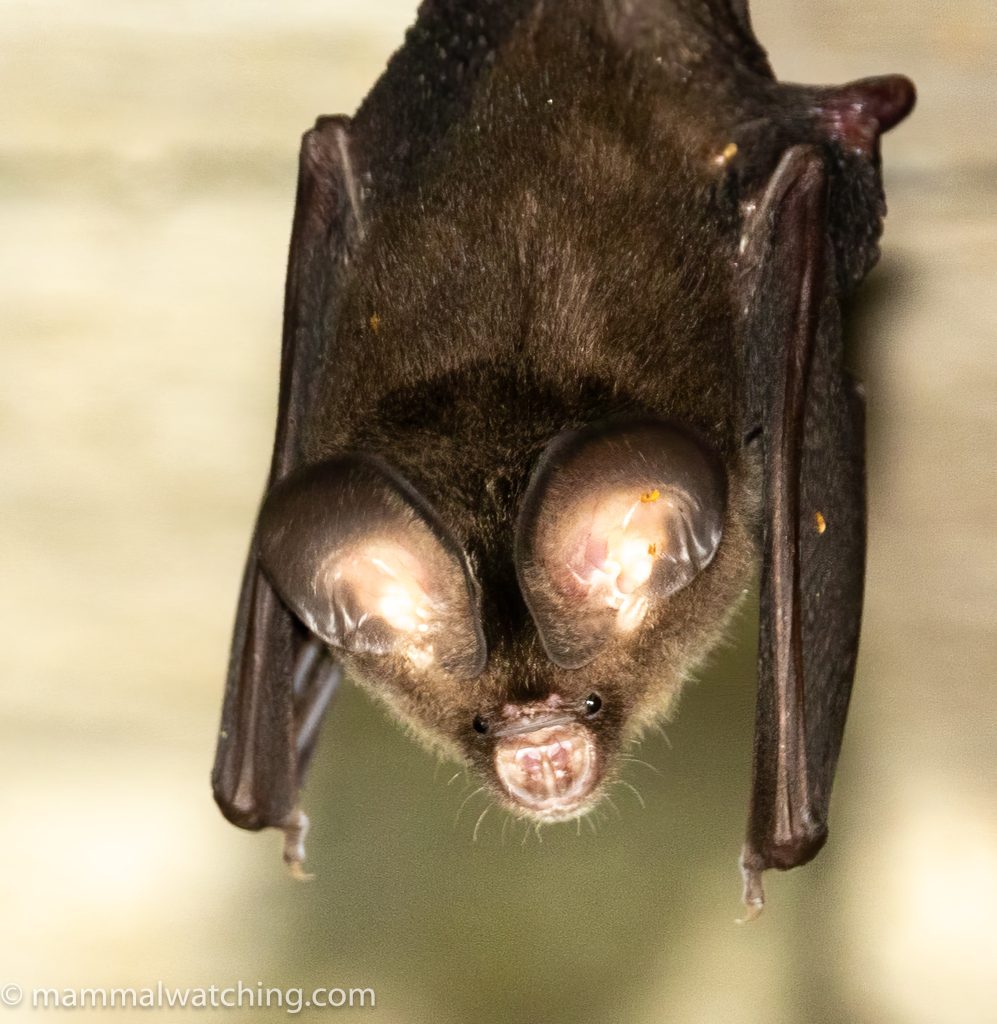
Andersen’s Leaf-nosed Bat (Hipposideros gentilis)
And a handful of Great Himalayan Leaf-nosed Bat that dwarfed their relatives.
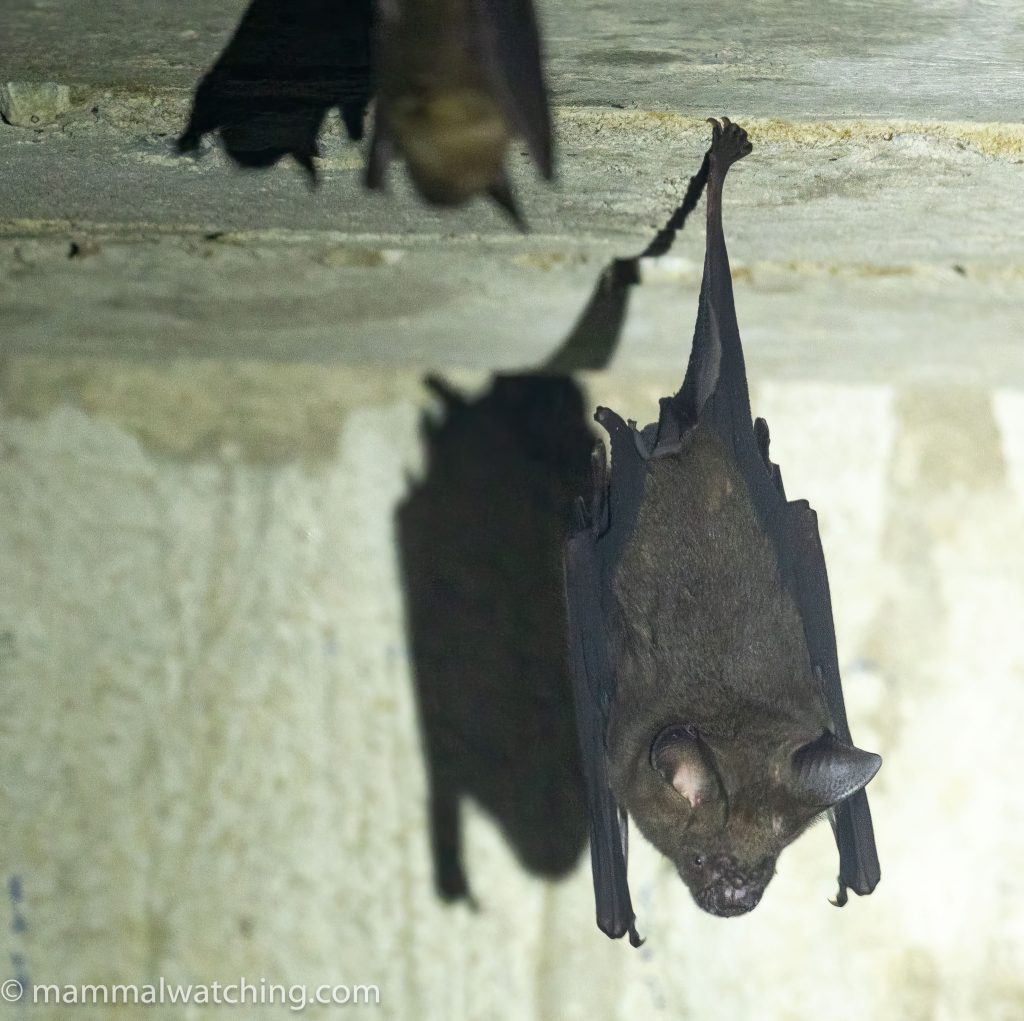
Great Himalayan Leaf-nosed Bat (Hipposideros armiger)
And then Tour drove me back to Bangkok in time for dinner.
Many thanks again to Tour and Coke for showing me around so well and for being such good company. Thanks to Carlos Bocos for his real time bat roost intel. And a big thanks to Pipat Soisook for patiently – and immediately – identifying the species in the 100 or so photos I sent him.
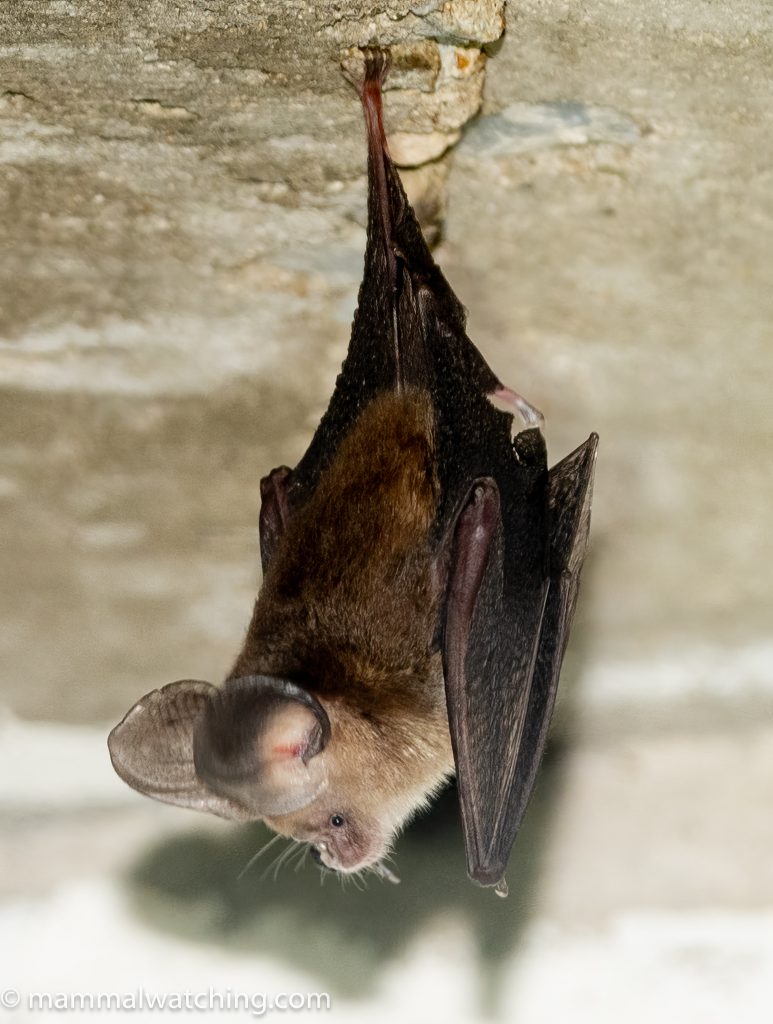
Andersen’s Leaf-nosed Bat (Hipposideros gentilis)
Trip List
Black Giant Squirrel (Ratufa bicolor)
Gray-bellied Squirrel (Callosciurus caniceps)
Finlayson’s Squirrel (C.finlaysonii)
Crab-eating Macaque (Macaca fascicularis)
Northern Pig-tailed Macaque (M.leonina)
Dusky Leaf-monkey (Trachypithecus obscurus)
Lar Gibbon (Hylobates lar)
Sunda Short-nosed Fruit Bat (Cynopterus brachyotis)
Lesser False Vampire (Megaderma spasma)
Great Himalayan Leaf-nosed Bat (Hipposideros armiger)
Cantor’s Leaf-nosed Bat (H.galeritus)
Andersen’s Leaf-nosed Bat (H.gentilis)
Horsfield’s Leaf-nosed Bat (H.larvatus)
Malayan Horseshoe Bat (R.malayanus)
Pearson’s Horseshoe Bat (R.pearsonii)
Shamel’s Horseshoe Bat (R.shameli)
Black-bearded Tomb Bat (Taphozous melanopogon)
Medium Bent-winged Bat (Miniopterus medius)
Common Woolly Bat (Kerivoula hardwickii)
Lesser Large-footed Myotis (Myotis hasseltii) (possible)
Himalayan Whiskered Bat (M.siligorensis)
Northern Red Muntjac (Muntiacus vaginalis)
Serow (Capricornis sumatraensis)
23 species and 5 lifers (in bold)
Post author
4 Comments
-
-
JanEbr
You go to these places with wonderful animals and look at bats all the time … 🙂 I think the Sun Bear must be one of the very few instances where we were actually lucky with an animal. It was in the camp only for a short while and we basically saw it only because we – very untypically for us – made a friend there (but, as you probably know from my report, it also came back in the night).
Leave a Reply
You must be logged in to post a comment.


tomeslice
Hey Jon,
Great stuff!
Regarding the sun bear, I can just add that Jonathan Ben-Simon (who hasn’t submitted his report yet) was there a few months ago, I think around May, and spent the night at that campsite. He actually didn’t see the bear, but when inspecting his trail cam that he set up outside the tent, he was disappointed to find out that it did in fact show up, but only around 4am… That’s all the information I have regarding that.
By the way, regarding bats – you would have been so proud of me when I went on my solo day-tour for the ring-tailed lemur, I went by myself, of my own free-will, to go see the long-fingered bats at the mini road-side cave on the way back to Ranomafana. Alex, Jonas and Ruta were all shocked when I told them this.. I can no longer be labeled as the bat hater ..!! 😀